The archaeological site Umm er-Rasas is inscribed on the UNESCO’s World Heritage List. And there are many reasons for that. Among others, the numerous ruins that can be seen at this site date back to the Roman, Byzantine and Muslim periods (from the end of the 3rd to the 9th century).
This is certainly noteworthy, but probably one of the most important reasons for the significance of Umm er-Rasas is the mosaic floor at the Church of St. Stephen found in situ. The mosaic was made in 785 CE, it was discovered after 1986 and this is the biggest mosaic floor in Jordan.
The Church of St. Stephen is a part of a complex of densely built churches and courtyards. There are practically 5 churches and 2 courtyards compacted one next to the other and this has all been covered by a roof structure in order to ensure protection. In addition, the visitors cannot walk over the floors of the churches and the courtyards, but rather there is a specially made path, elevated like a platform that allows better view at the mosaics.
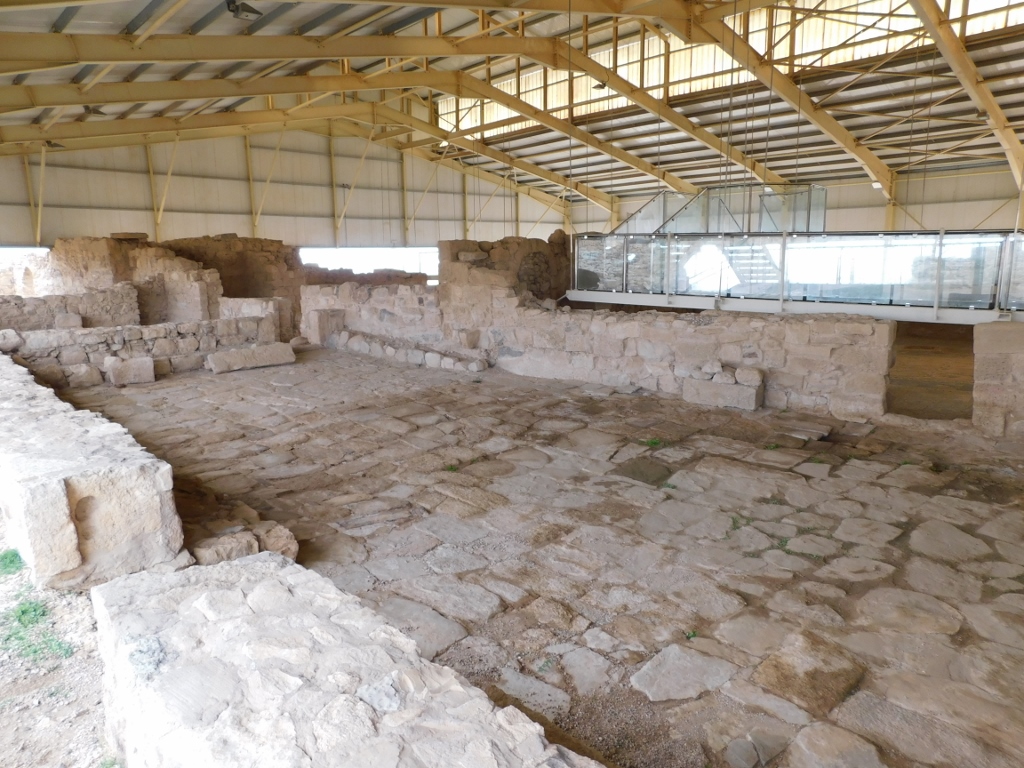 St. Stephen’s Complex within the archaeological site Umm er-Rasas – Chapel of the Column
St. Stephen’s Complex within the archaeological site Umm er-Rasas – Chapel of the Column
The chapel has been named like this because under the floor of the church the archaeologists have discovered the base of a column from the 7th-8th century BCE. So, the name has nothing to do actually either with the chapel itself or with Christianity. The name was given simply as a practical description.
The path leads over the Chapel of the Column to the Church of St. Stephen.
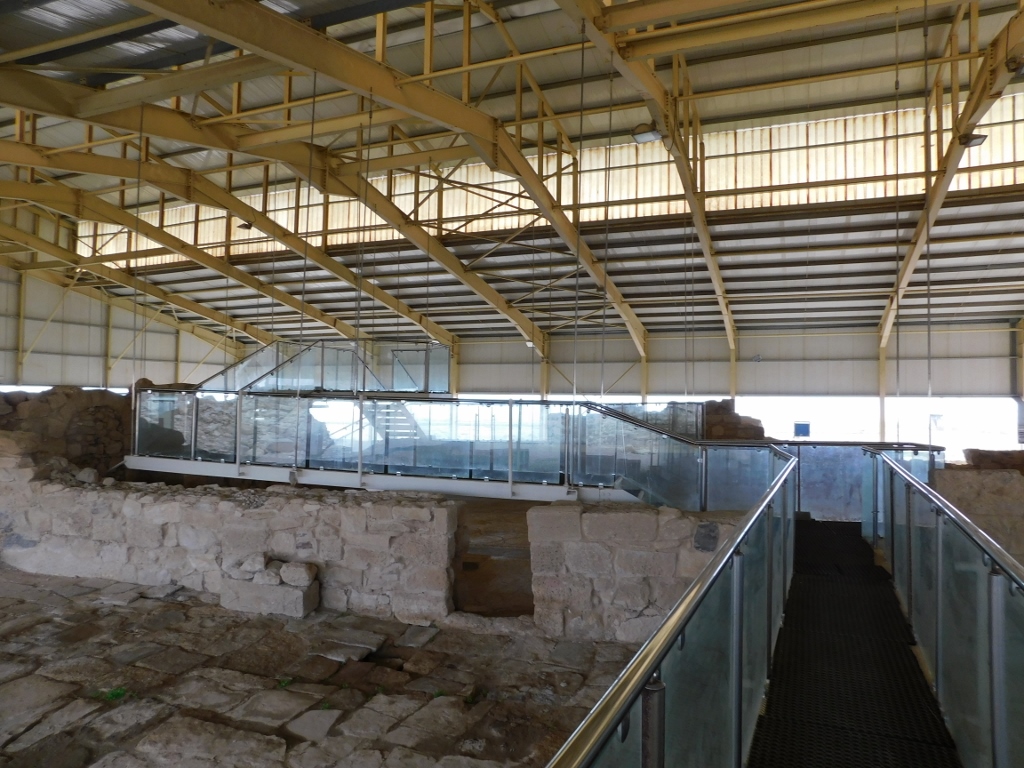 St. Stephen’s Complex
St. Stephen’s Complex
The Church of St. Stephen was built in 785 over an older building. It has this floor mosaic that is over 1200 years old and the wealth of inscriptions and the quality of that mosaic make the Church of St. Stephen one of the most important monuments in Jordan.
As you walk along the elevated visitor path, you first come across the presbyterium and the sacristy.
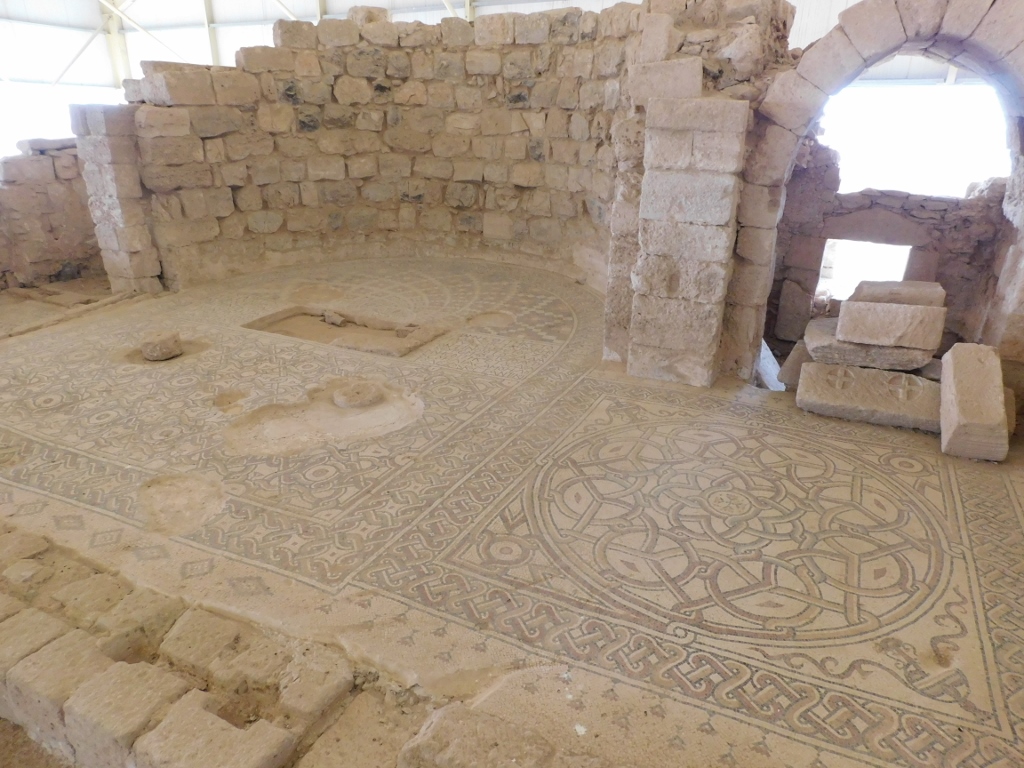 Church of St. Stephen, the presbyterium and the sacristy
Church of St. Stephen, the presbyterium and the sacristy
Already at first sight it was clear that the beauty of the mosaic was absolutely stunning. And yet, the mosaics that I saw were comparatively pale, which is a consequence of the fact that it was winter with a lot of wind that carried sand, since this complex is covered by a roof construction, but practically everything else is open as there are no walls. It is possible to find on the internet photographs where the colours of the mosaic are significantly more intensive, which certainly accentuate their indisputable beauty even more.
Within the presbyterium (in the photo above to the left), there is a mosaic inscription that says that two master craftsmen did the floor in the presbyterium in March of 756.
In front of the sacristy (in the photo above to the right), it is possible to see a medallion with a cross made of flowers in the centre and surrounded by intertwined circles.
Then the path took me to the central nave of the church that is completely covered by the mosaic. The impression was absolutely incredible.
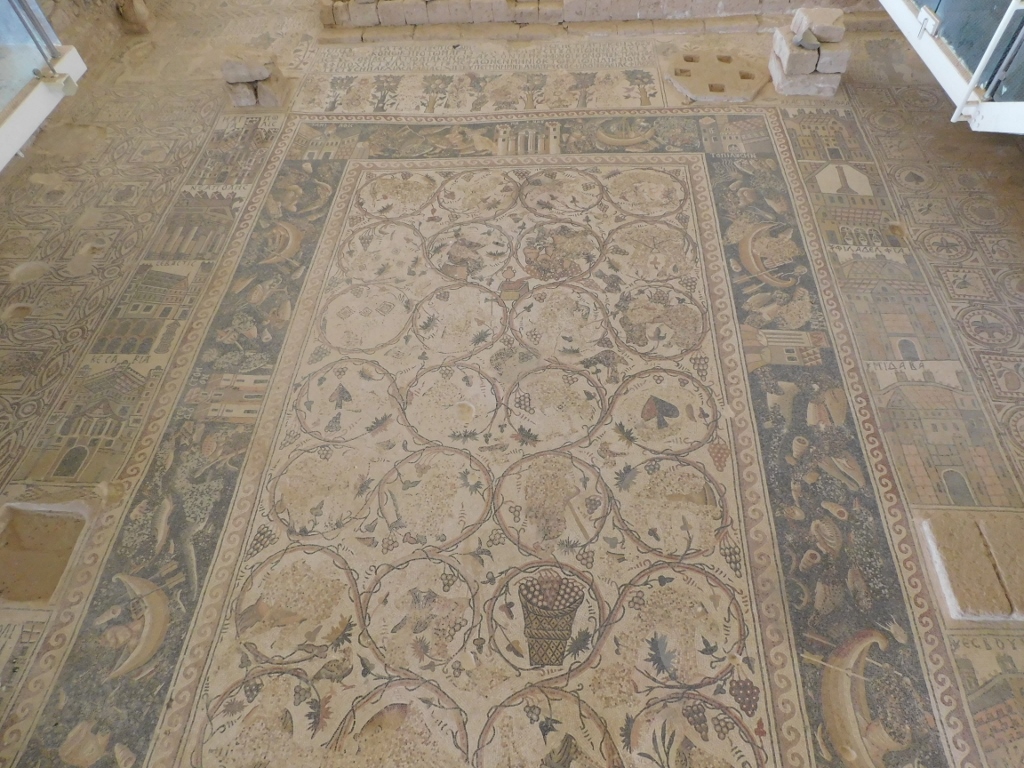 Church of St. Stephen, frontal view at the floor of the naos
Church of St. Stephen, frontal view at the floor of the naos
In the central part of the “carpet” of the central nave, there are different hunting, agricultural and pastoral scenes that fill the circles made of vines. However, with time, the iconoclasts have destroyed all the figures by removing them and putting in lieu mosaic cubes without any sense.
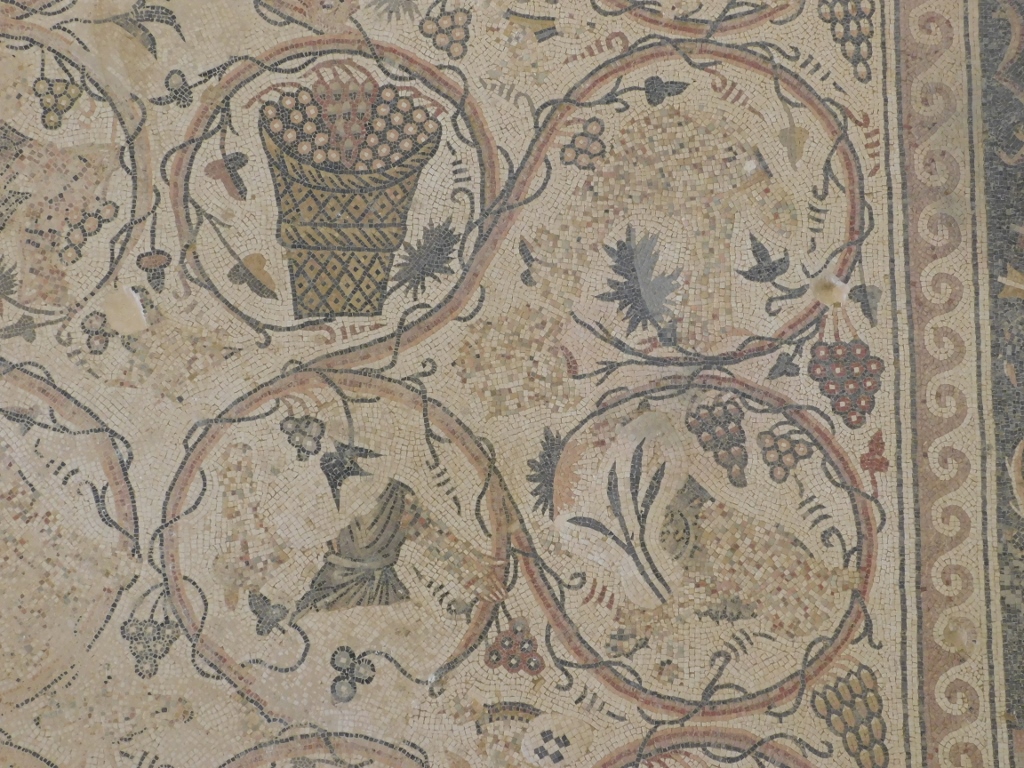 Church of St. Stephen, a detail
Church of St. Stephen, a detail
Around the central carpet goes a wide frame, like a river, depicting fish, birds, different water plants and animals, as well as boats and people who fish and hunt. This sequence is occasionally interrupted by the depiction of ten cities located in the Nile delta. The Nile was considered one of four rivers in Paradise and thus it was an integral part of Christianity.
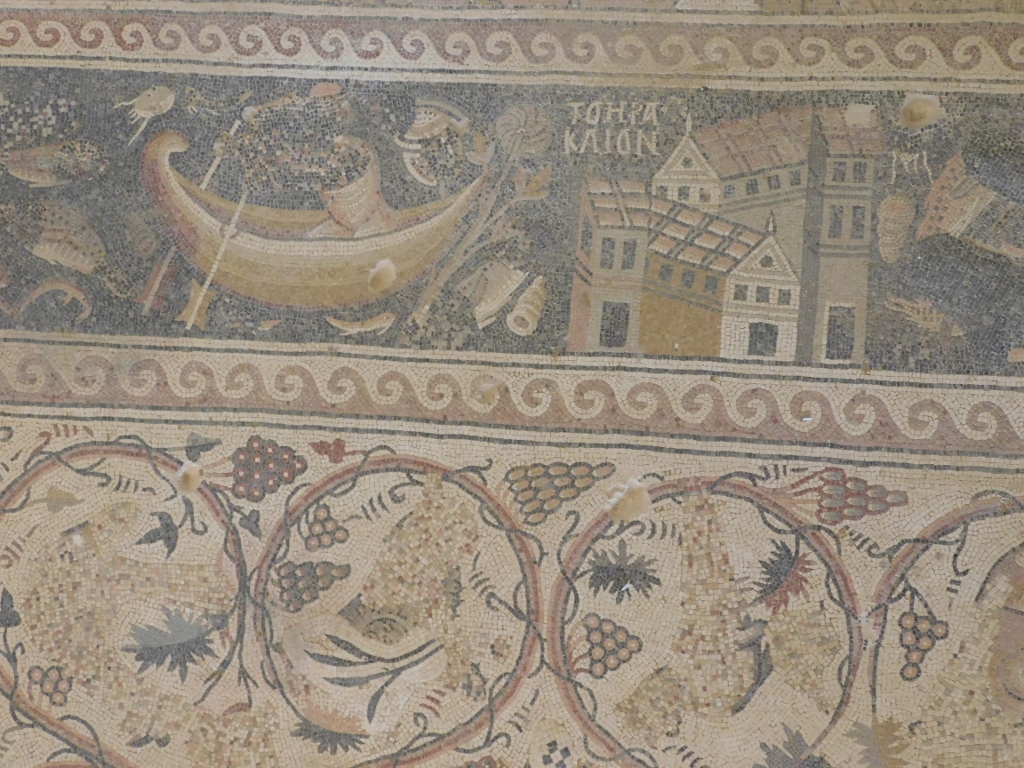 Church of St. Stephen, a detail
Church of St. Stephen, a detail
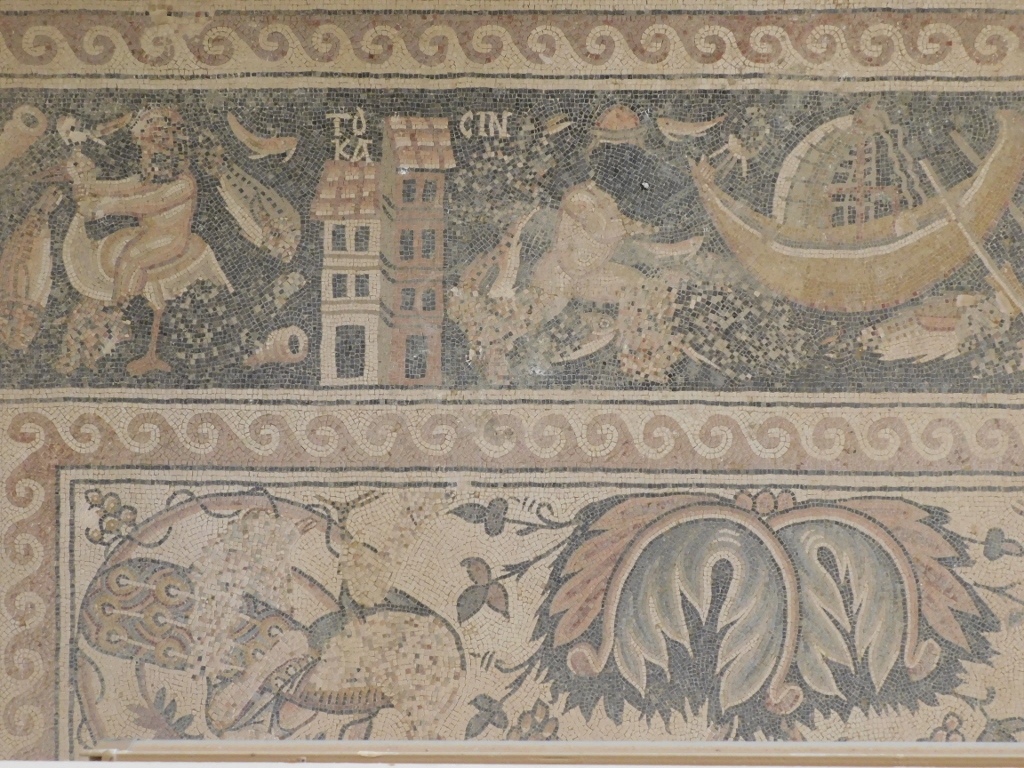 Church of St. Stephen, a detail
Church of St. Stephen, a detail
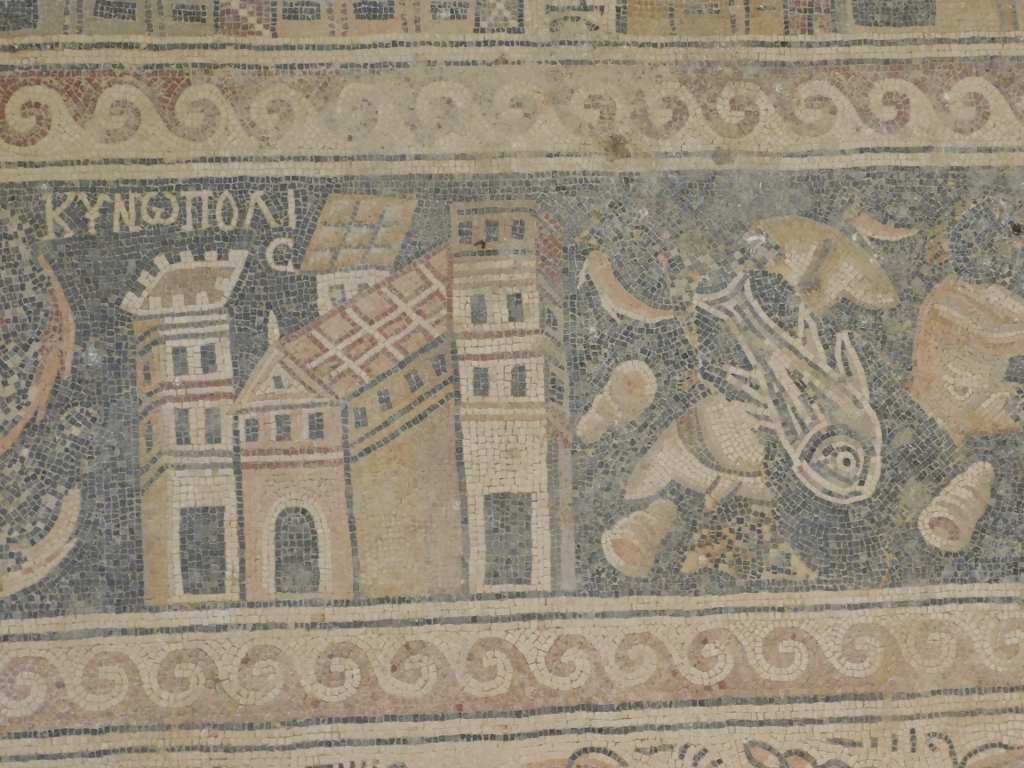 Church of St. Stephen, a detail
Church of St. Stephen, a detail
To the north and south from the carpet (in the overall photo above to the left and right), there are depictions of cities with their names written in Greek. On the left-hand side there are eight cities west of the Jordan river and on the right-hand side there are seven cities east of the Jordan river. The right-hand sequence starts with the depiction of Umm er-Rasas which was called Kastron Mefaa in the past. Note in particular the high tower shown against the light-coloured background under the depiction of the buildings and the fortress. A little more about that very interesting element later on.
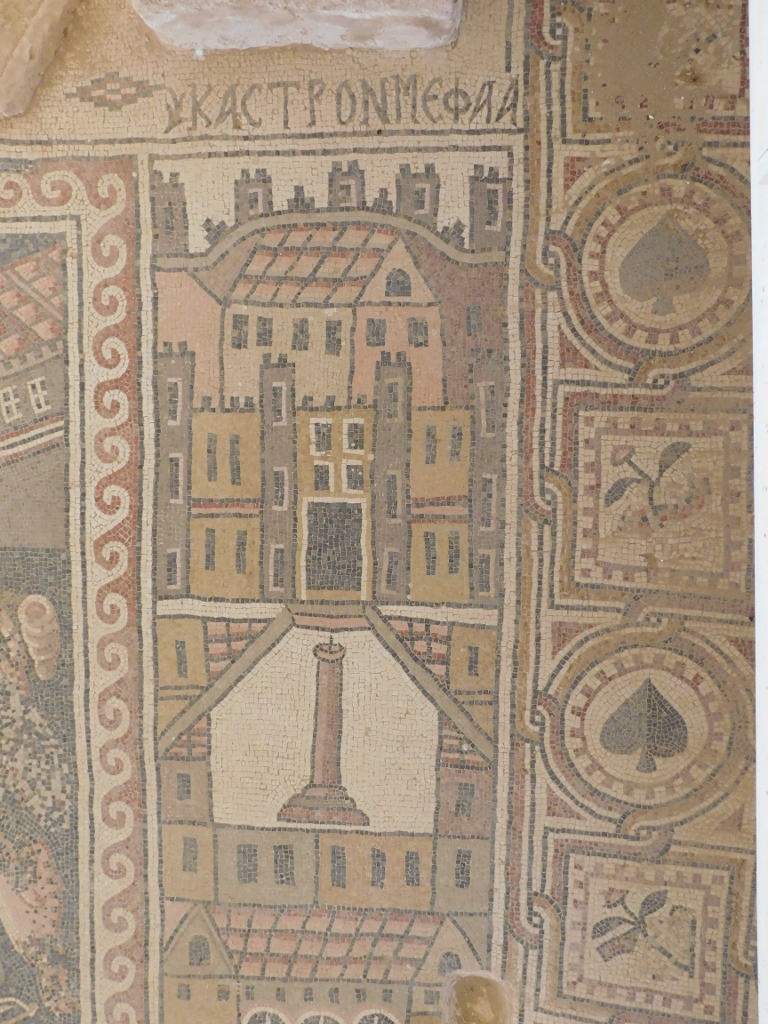 Church of St. Stephen, a detail
Church of St. Stephen, a detail
This is followed by Amman, formerly Philadelphia, and Madaba.
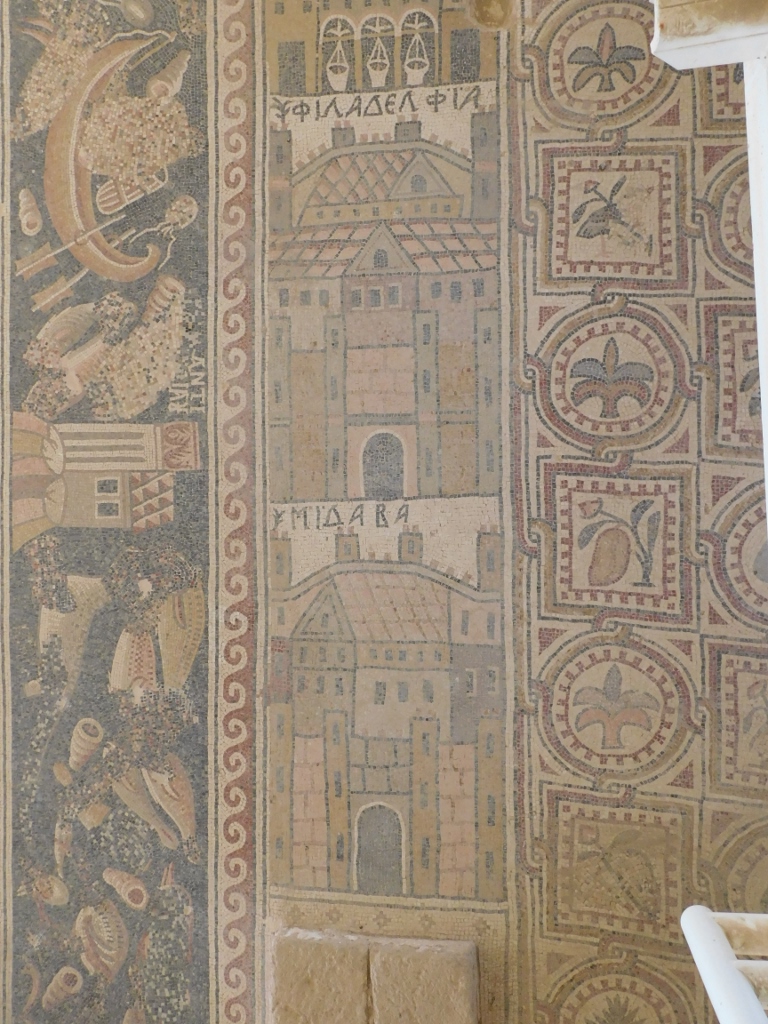 Church of St. Stephen, a detail
Church of St. Stephen, a detail
On the left-hand side there are, as I’ve said, depictions of cities west of the Jordan river and here are a few of them:
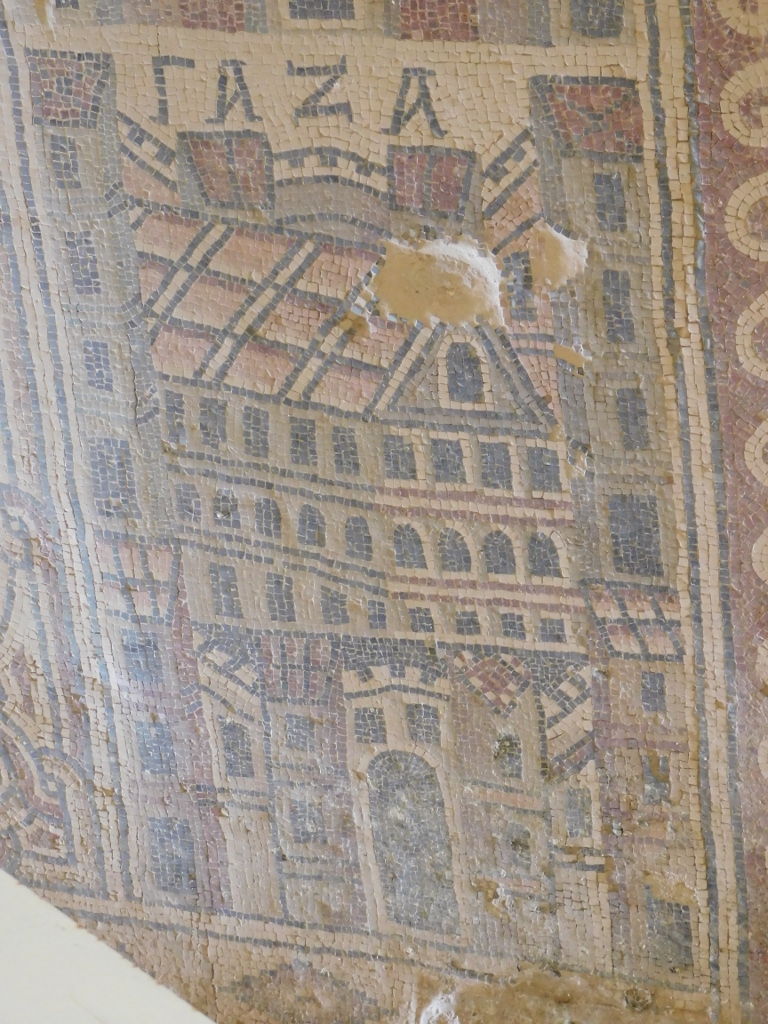 Church of St. Stephen, Gaza
Church of St. Stephen, Gaza
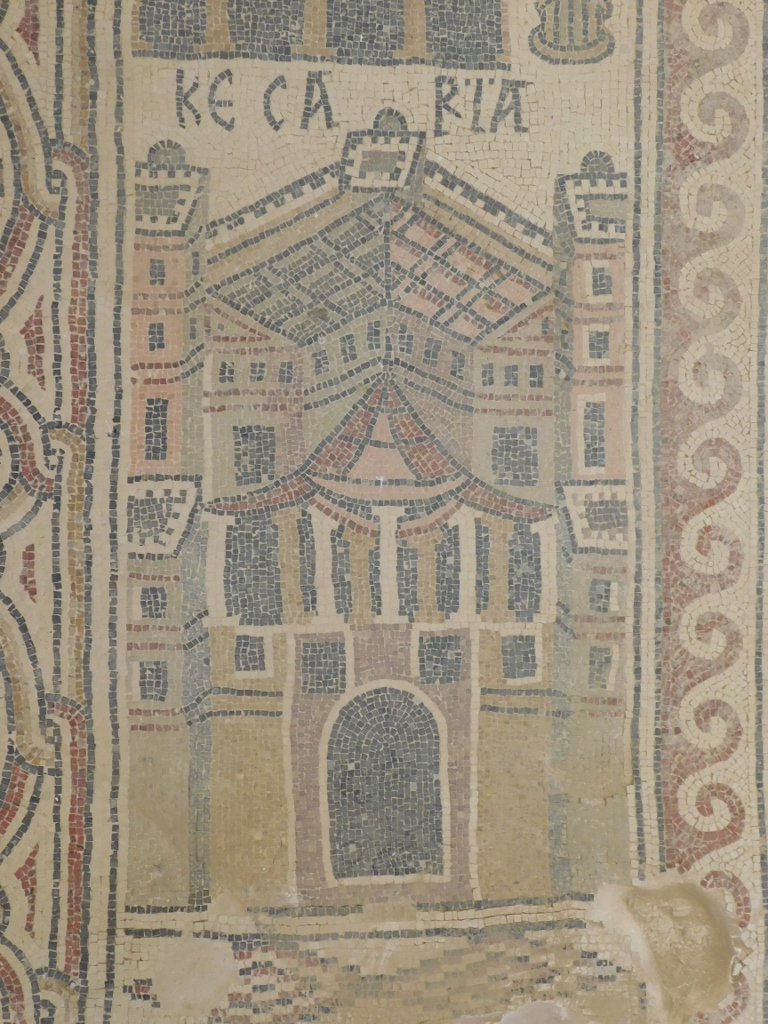 Church of St. Stephen, Caesarea
Church of St. Stephen, Caesarea
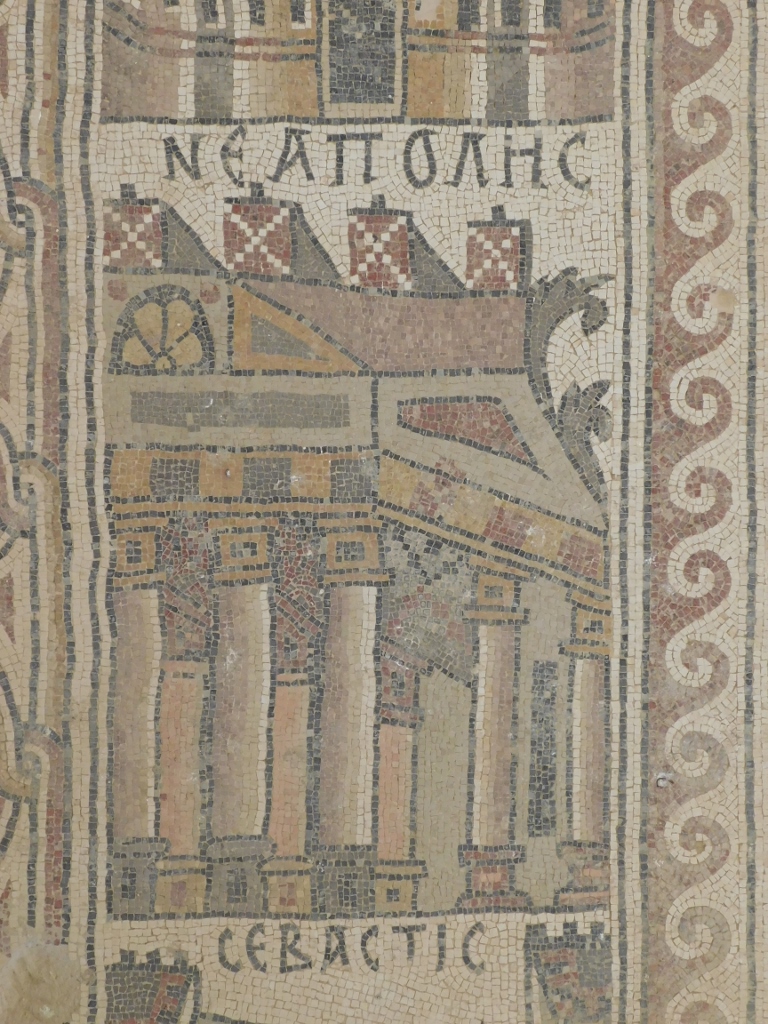 Church of St. Stephen, Nablus
Church of St. Stephen, Nablus
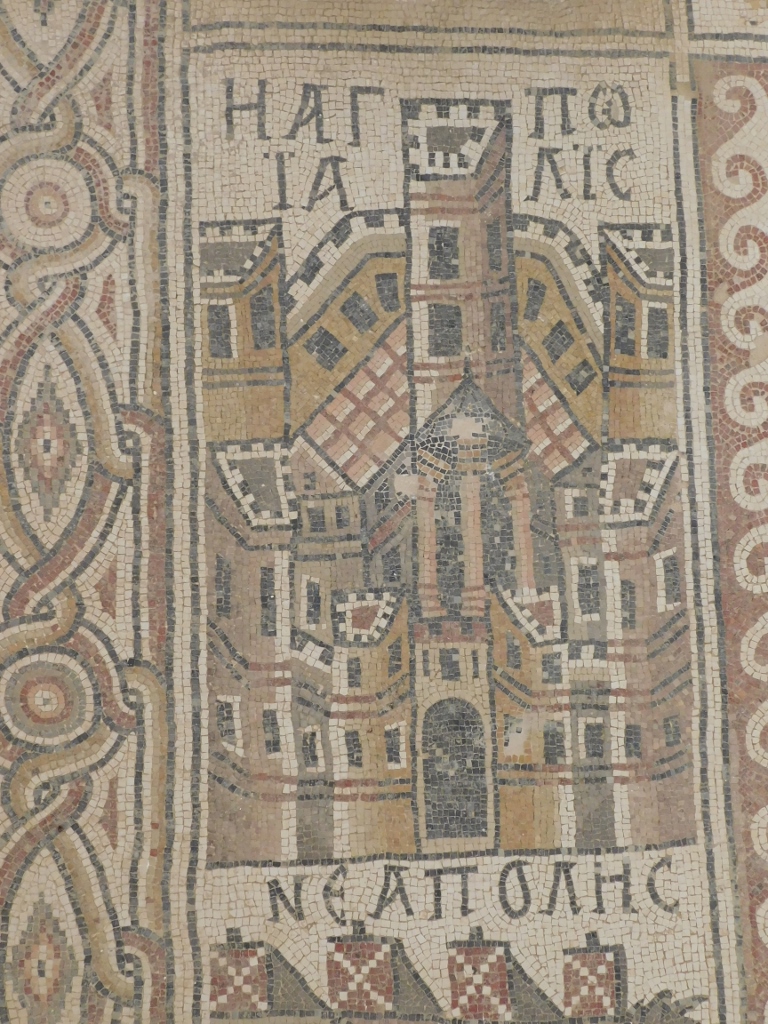 Church of St. Stephen, Holy City, i.e., Jerusalem
Church of St. Stephen, Holy City, i.e., Jerusalem
These two longitudinal sequences with the depictions of the cities filled out in fact the space between the columns that separated the nave from the aisles. The aisle on the north side ends in a chapel with an apse. The floor of the chapel is also decorated with a mosaic.
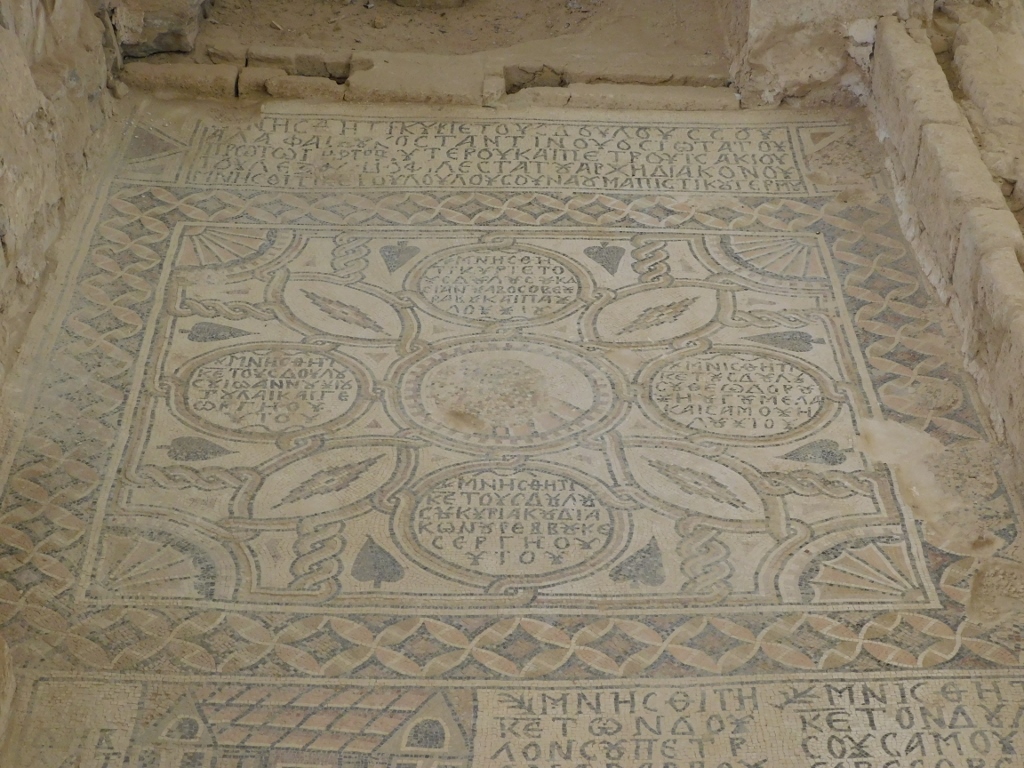 Church of St. Stephen, floor of the chapel north of the presbyterium
Church of St. Stephen, floor of the chapel north of the presbyterium
In front of the chapel there is a mosaic depiction of the village of Diblation and there are also portraits and names of benefactors. The only problem is that the images of men could not be seen since they were destroyed by the iconoclasts.
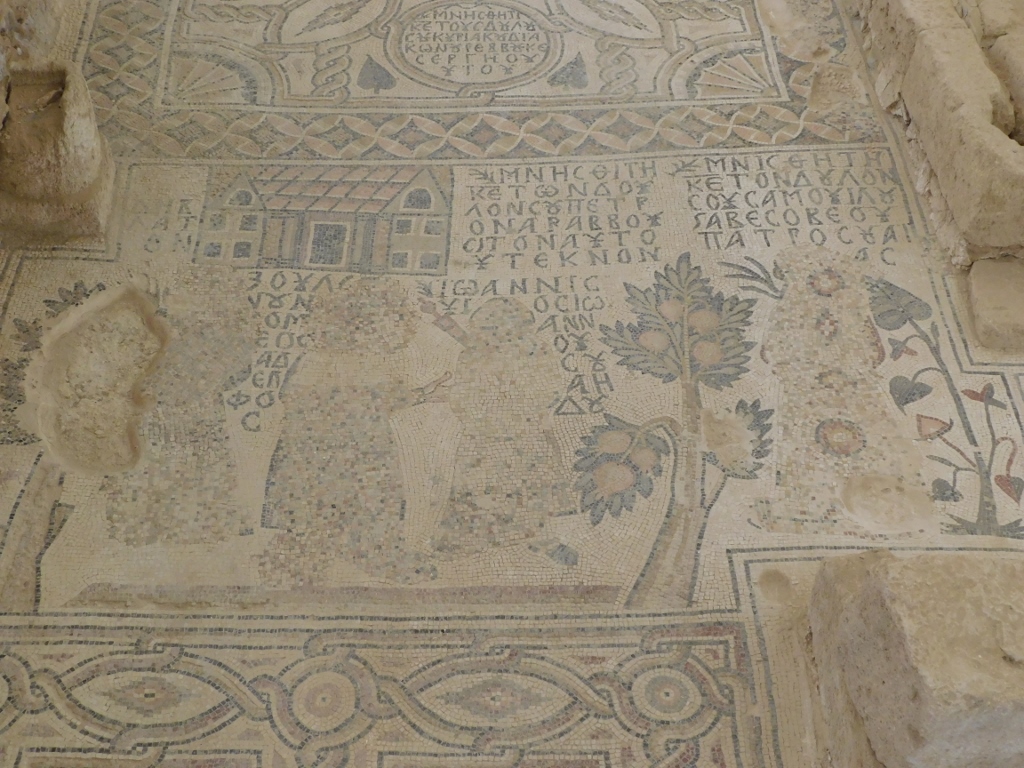 Church of St. Stephen, a detail
Church of St. Stephen, a detail
To the right from the mosaic shown in the photo above, there is a mosaic inscription with a dedication which extends along the step of the presbyterium. Below the inscription there is a sequence of benefactors shown as gift bearers, but the iconoclasts have destroyed their images as well.
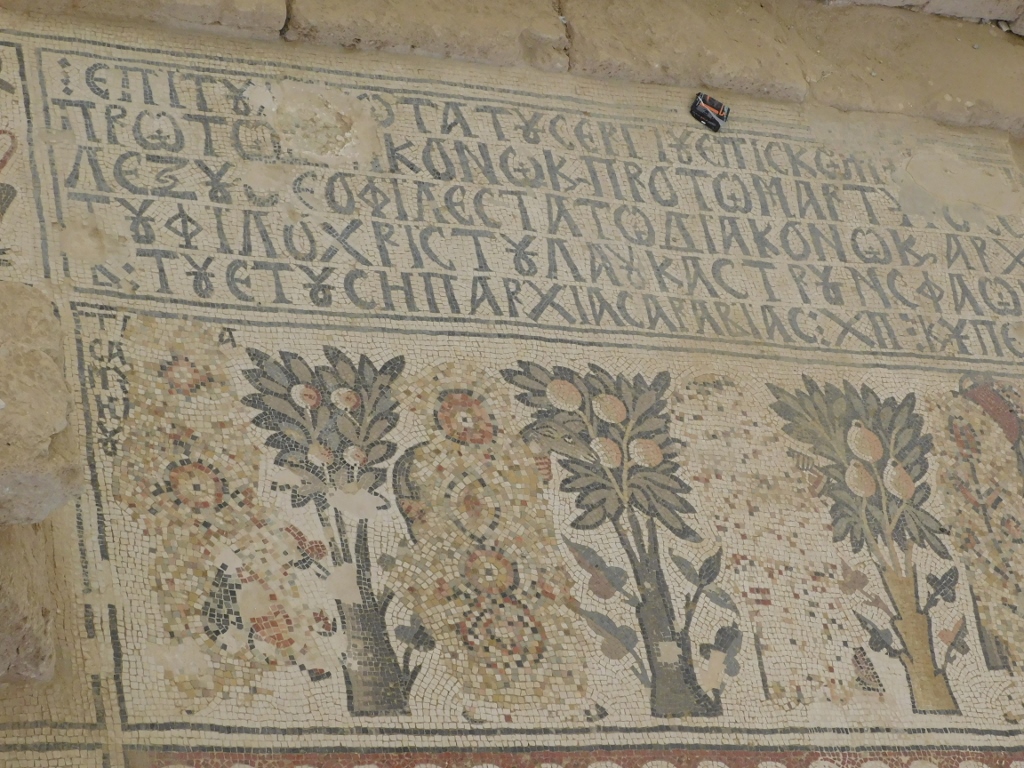 Church of St. Stephen, a detail
Church of St. Stephen, a detail
Literally right in front of the Church of St. Stephen there used to be a courtyard which was, presumably in the 8th century, turned into yet another church and that is why its remains are nowadays called the Courtyard Church. The researchers assume that the church was used as a sepulchral church since several graves have been found under the stone slabs that cover its entire floor. It was entered from the side, i.e., from the south side.
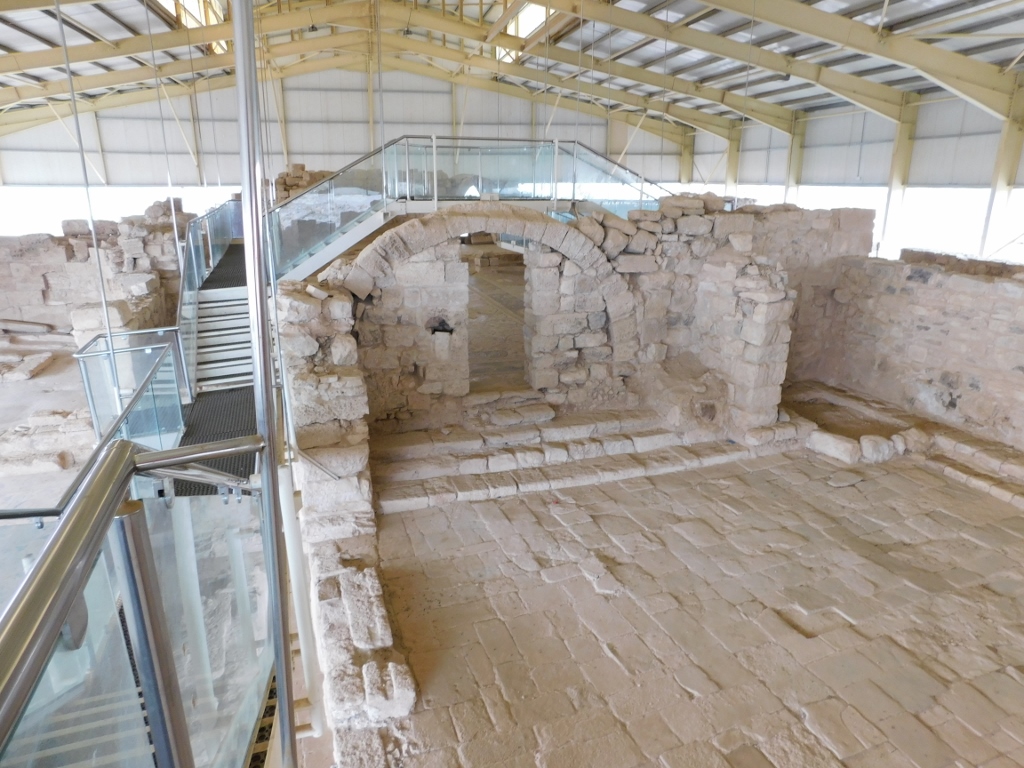 Courtyard Church
Courtyard Church
I was, however, still under the impression created by the superb mosaics I had seen previously and which I could see again through the arch and passage in the wall seen across the area of the Courtyard Church.
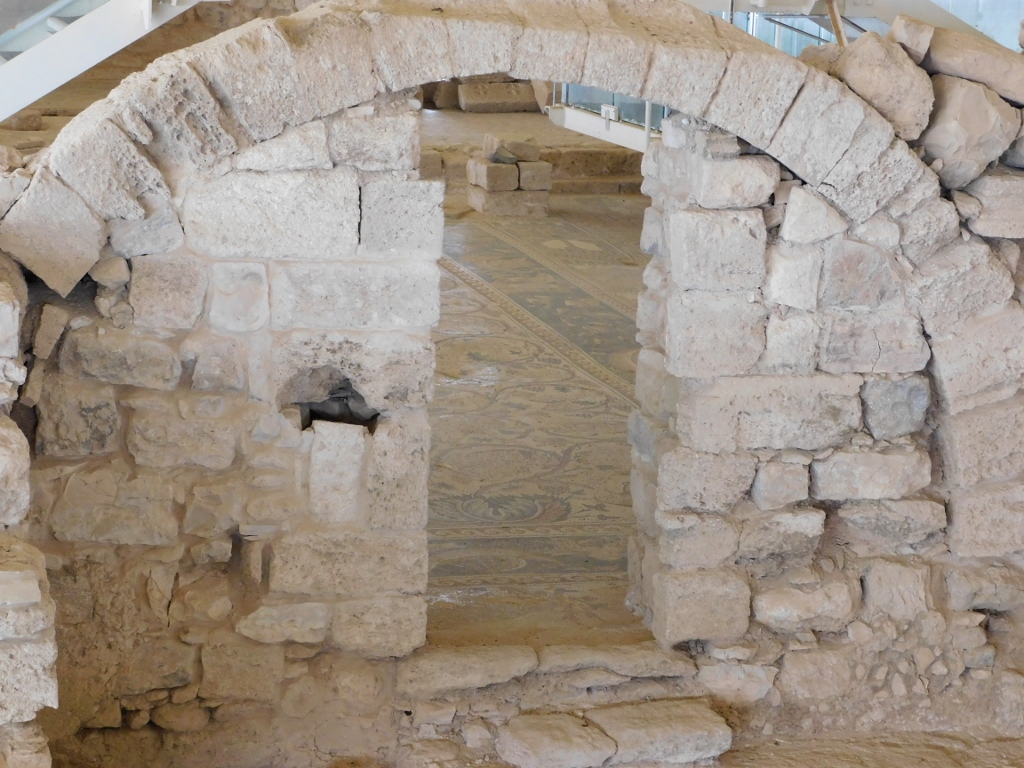 View at the floor of the Church of St. Stephen
View at the floor of the Church of St. Stephen
Directly flanking the Church of St. Stephen and the Courtyard Church, there are remains of the Church of Bishop Sergius. An inscription in the mosaic floor of this church says that it was built in 586 CE, which means that actually the other two churches lean against this one, since it is older.
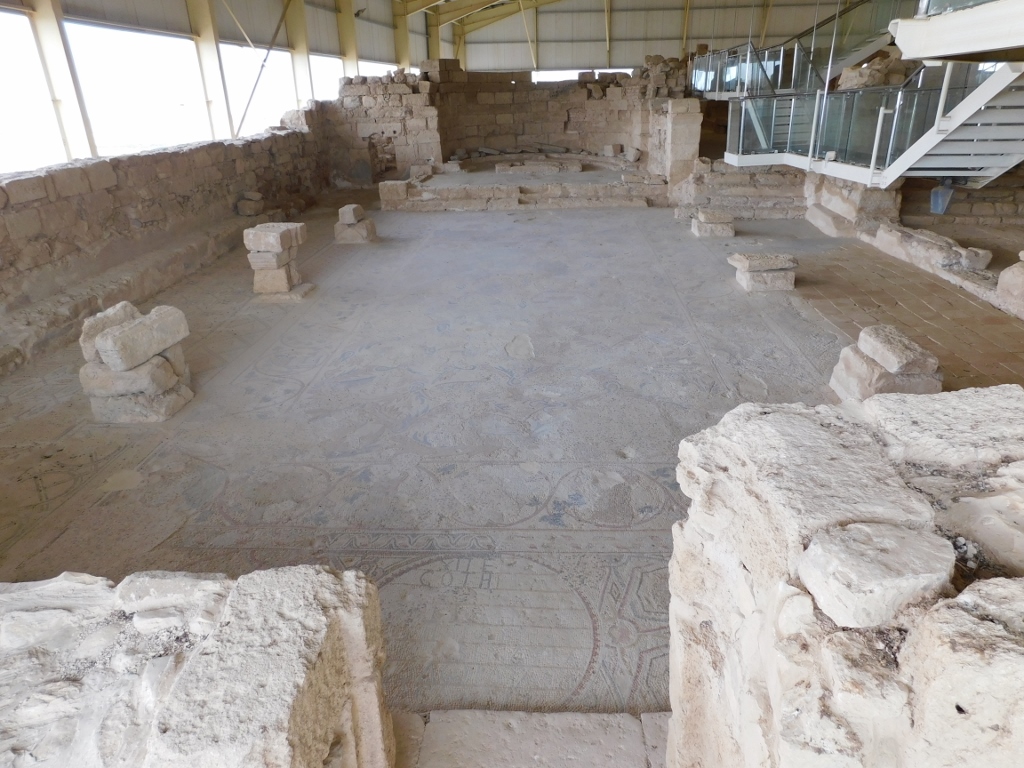 Church of Bishop Sergius
Church of Bishop Sergius
Here too there is a central mosaic carpet that is full of opulent decorations, but like in the case of the other depictions, the iconoclasts removed figures. A rare exception is the southeast corner of the carpet’s border where there used to be a pulpit or more accurately its heavy stone base and so the human image has survived there since the iconoclasts did not move the stone. The depiction shows a young woman holding a cornucopia from which starts a vine that further creates circles with different depictions.
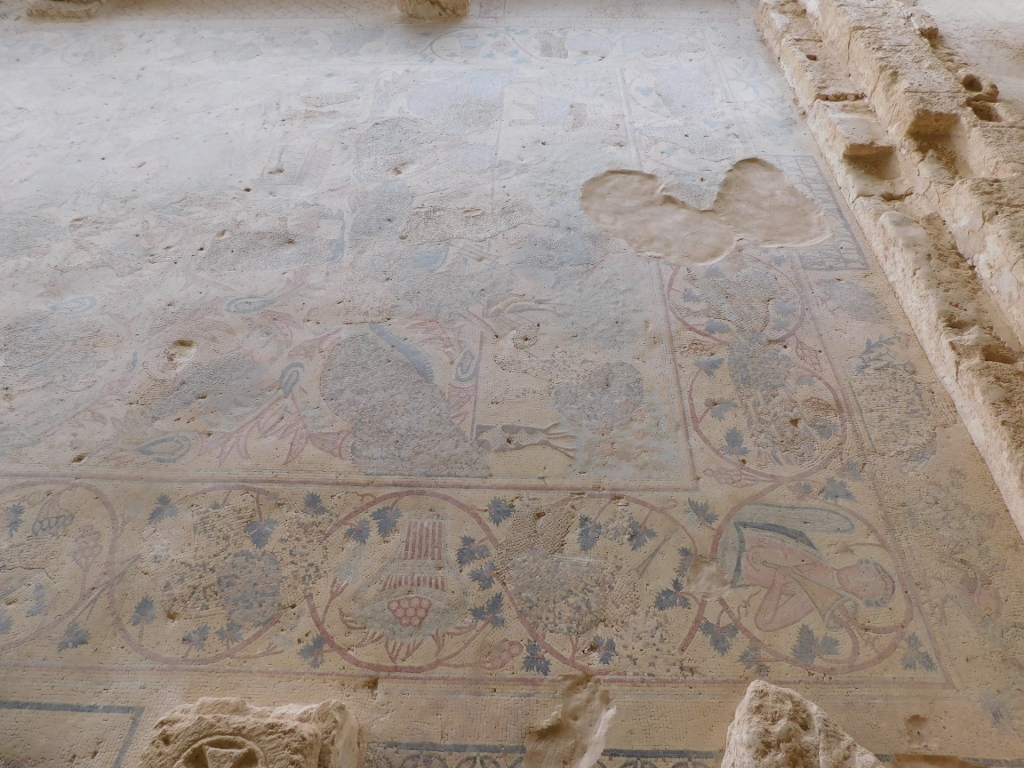 Church of Bishop Sergius, a detail of the mosaic floor, the human image is down to the right
Church of Bishop Sergius, a detail of the mosaic floor, the human image is down to the right
Still, the mosaic was even paler here than in the case of the Church of St. Stephen that is located more towards the centre of the roof structure and perhaps the impact of the sand carried by the wind is less pronounced over there. Let me say it again, the colours are significantly more intensive in some of the photos that can be seen on the internet and they appear as if somebody has just freshly washed the mosaic.
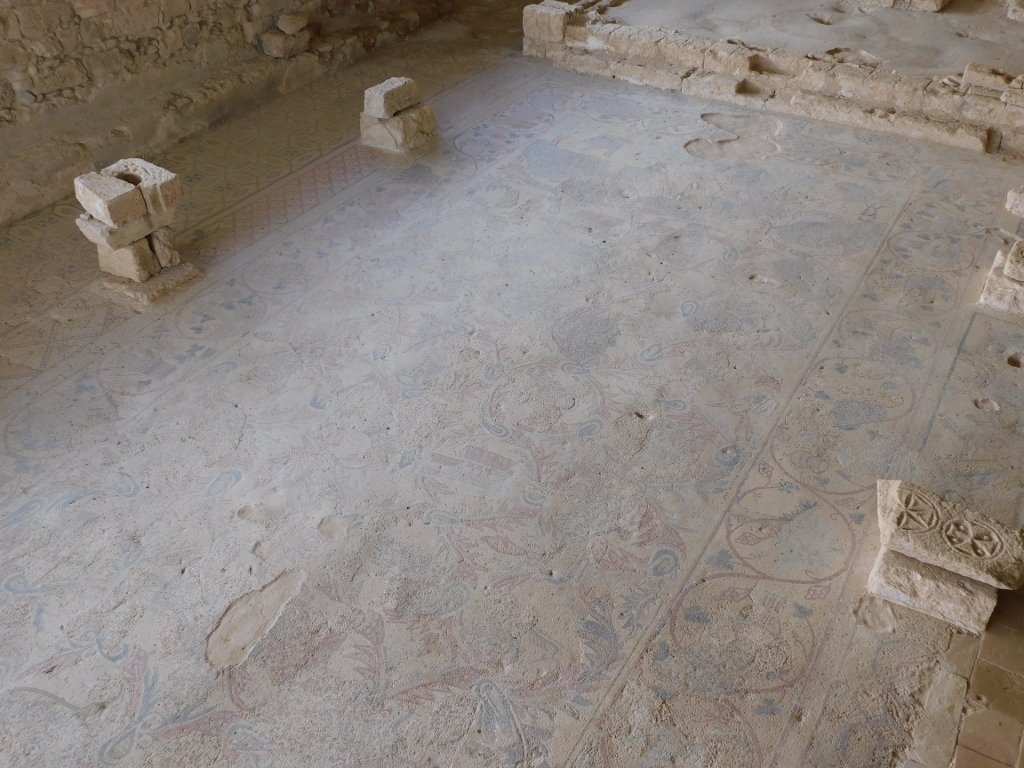 Church of Bishop Sergius, floor of the naos
Church of Bishop Sergius, floor of the naos
The presbyterium of the church has an apse and is elevated by two steps above the level of the naos. Its floor is also covered by a mosaic, but this too was very pale as can be seen in the photo below.
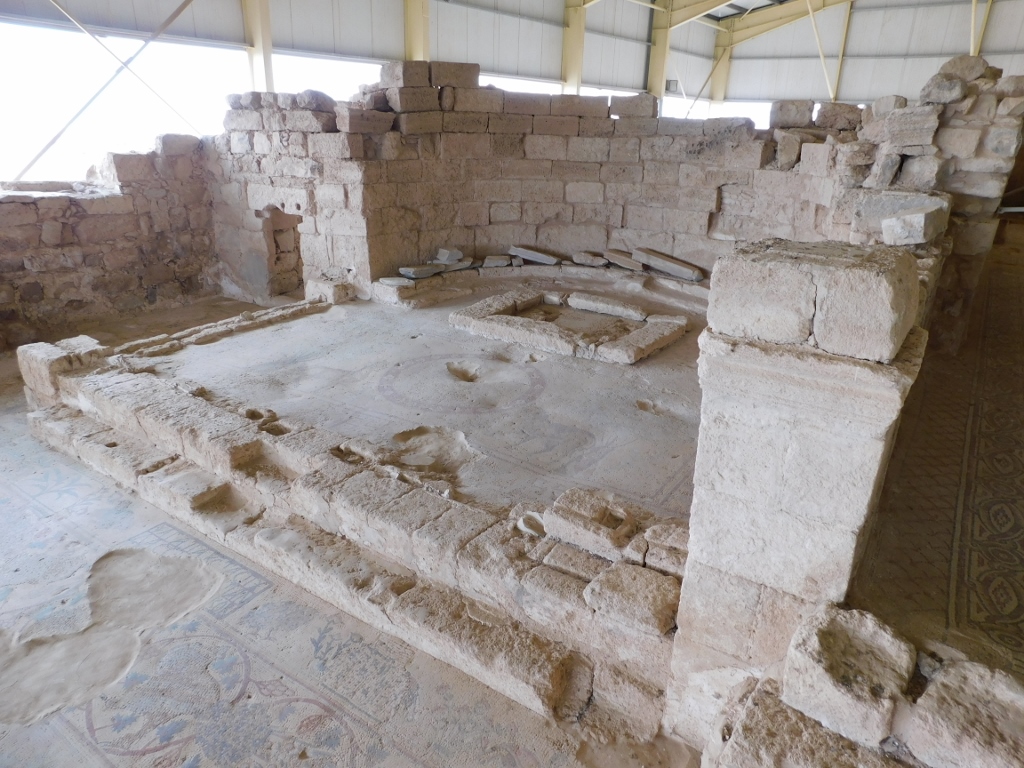 Church of Bishop Sergius, presbyterium
Church of Bishop Sergius, presbyterium
Here Abdullah and I practically finished with our sightseeing. We then walked from the outside beside the low remains of the north wall of the Church of Bishop Sergius. I took another photo of the church from there and it is also possible to see in the photo below the visitor path, as well as the roof structure that protects the Complex of St. Stephen.
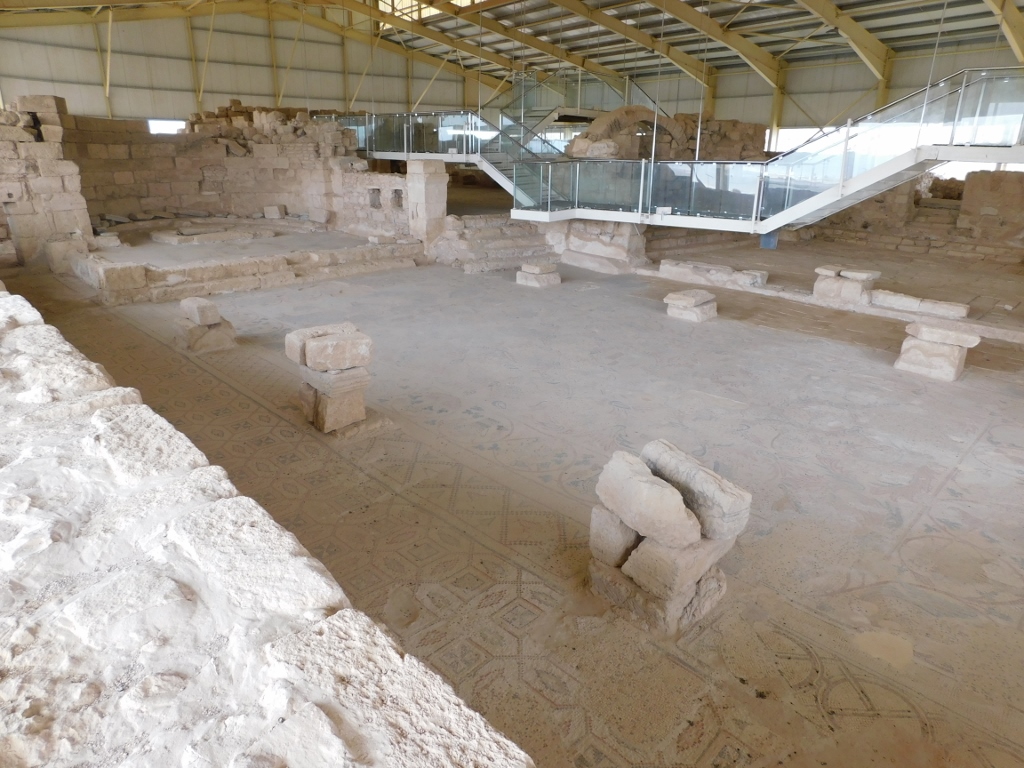 Church of Bishop Sergius and some other segments of the Complex of St. Stephen
Church of Bishop Sergius and some other segments of the Complex of St. Stephen
On the other side of the wall there was mostly the desert.
 Surroundings of the Complex of St. Stephen
Surroundings of the Complex of St. Stephen
Now we first went back to the car and then we drove a little farther away within the village of Umm er-Rasas because I wanted to visit a very, very interesting structure. This was a high tower with a square ground plan that was used by ascetics from the early period of Christianity who are also called the stylites.
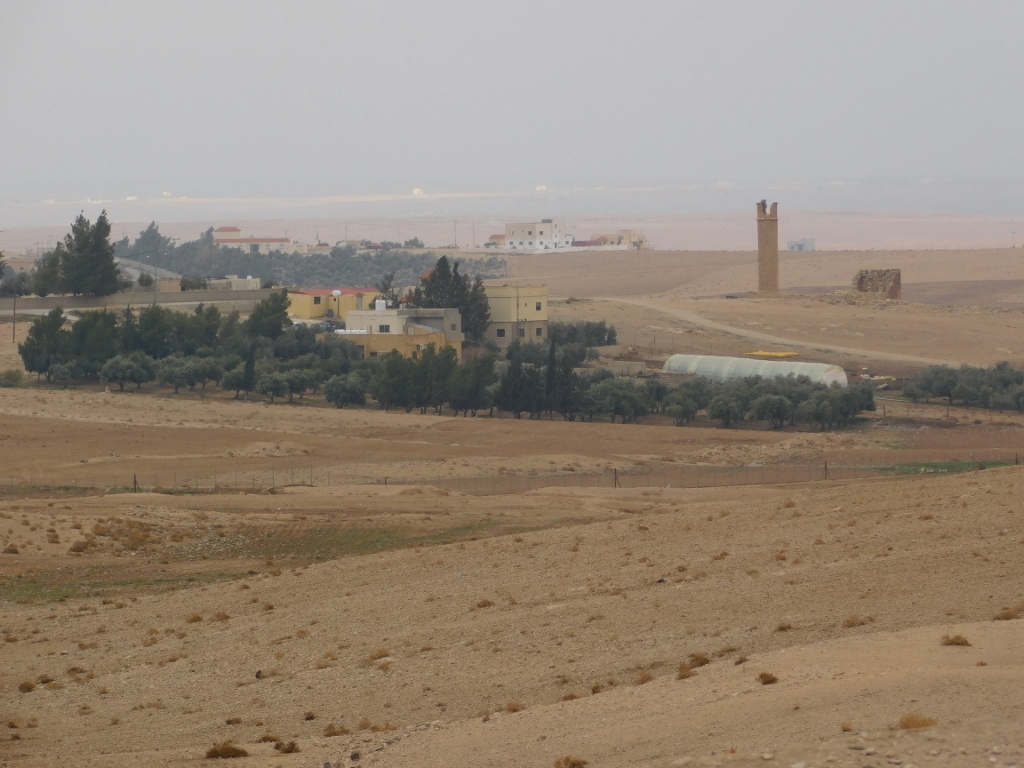 Stylite tower in the distance – we are going there
Stylite tower in the distance – we are going there
 Stylite tower in the middle of the desert
Stylite tower in the middle of the desert
The name “stylite” comes from the Greek word for “pillar.” These were, in other words, ascetics who lived on the top of the pillar, i.e., the tower from where they preached and where they prayed and fasted. Such practice appeared for the first time in the Byzantine province of Syria. The top of the pillar was linked to the ground with ladders and the achievement of these ascetics meant that they remained on the top irrespective of the weather conditions (temperature, rain, wind, etc.). Throughout the history, there has been a large number of stylites, including also some women. They were very much revered and as many as 7 stylites have been canonised.
It is believed that the first stylite was probably St. Simeon Stylites the Elder who started living on a pillar in 423 and did not dome down until his death in 459. On the other hand, he enjoyed tremendous respect and numerous pilgrims came regularly to his pillar in order to listen to his preaching or to climb up the ladders in order to ask Simeon for his advice or opinion.
This stylite tower that has survived in Umm er-Rasas, and that is shown in the mosaic of the city of Kastron Mefaa at the Church of St. Stephen (which I suggested earlier in the text), is a part of a complex that also includes a small church with additional chambers, a square-plan building with two floors, a water cistern and an old quarry.
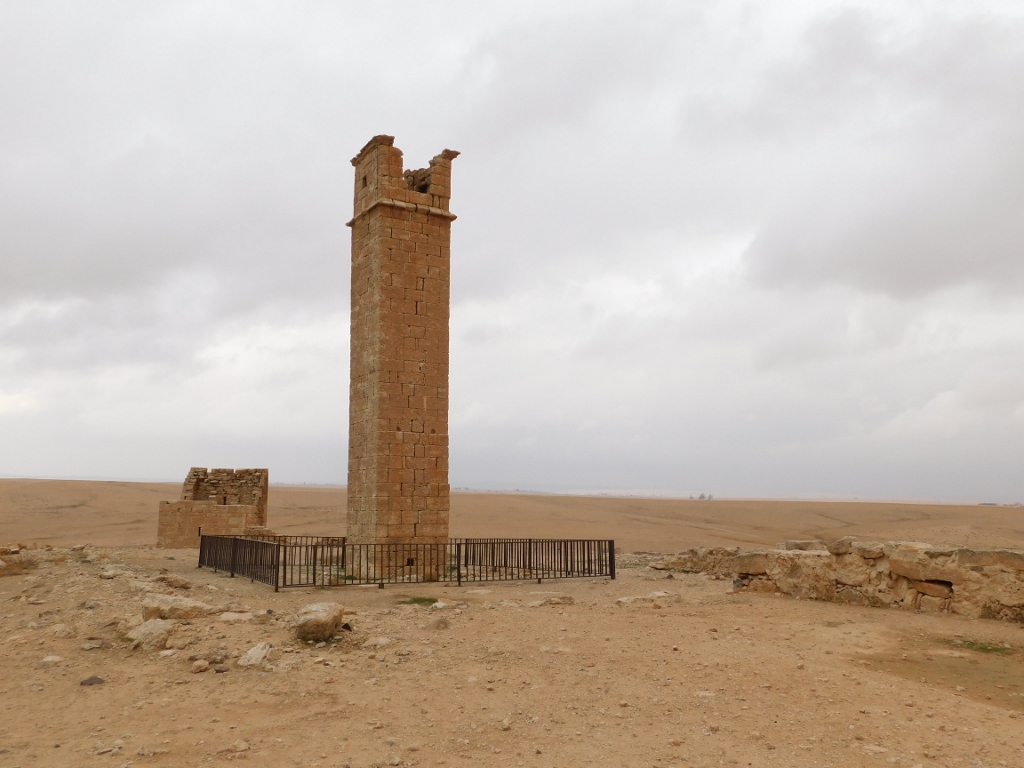 Stylite Tower Complex
Stylite Tower Complex
The tower was 14 m high and it seems that this is the only structure of this type of Christian hermitage that has survived to the present times. It is presumed that here too, like in the case of St. Simeon Stylites the Elder, many pilgrims and believers came in order to ask the stylite living here for advice or to pray for them or something of the sort. That explains the church beside the tower, the remains of which can be seen in the above photo to the right.
The tower has a shaft in the middle, but no steps. There was also a channel along the interior side of the wall that went from the top down and it is presumed that this served as a toilet. Also, the tower is practically closed from all sides and the only opening I saw, and I did make a circle around it, is the one that can be seen towards the bottom of the tower in the photo below. It is also possible to peek a little inside and all one can notice is the shaft. It is presumed that the food brought to the stylite would be put here into a basket which the stylite would then pull up through the shaft.
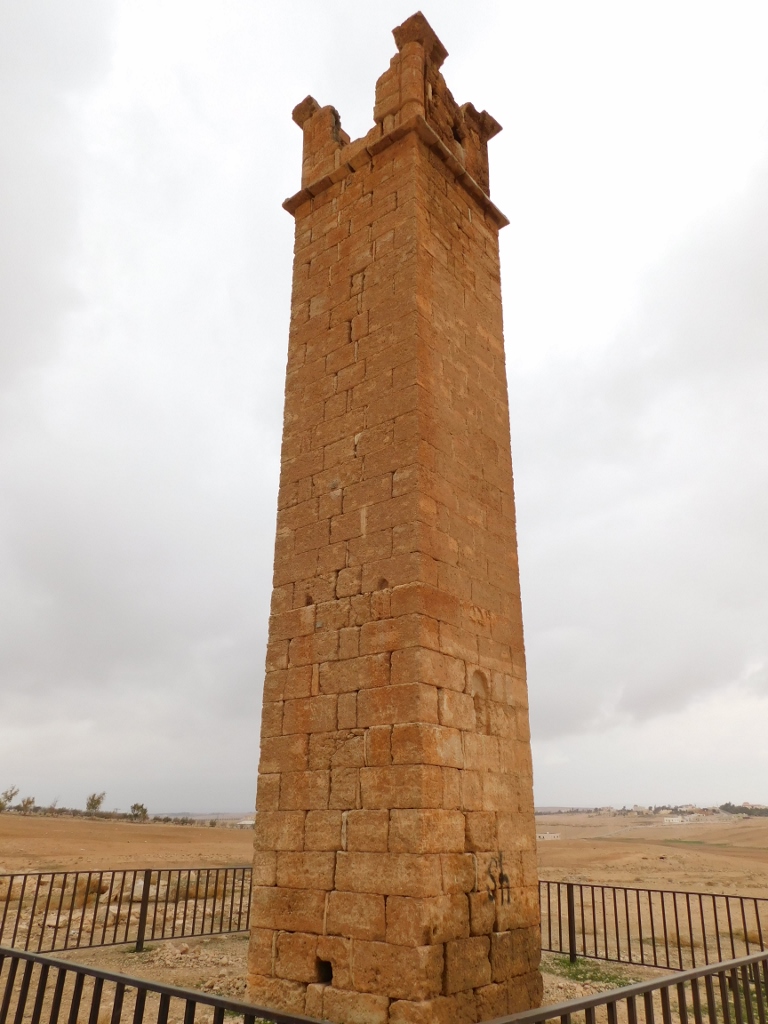 Stylite tower
Stylite tower
On the top, there used to be a domed room that was reached either by ropes or ladders.
On one side of the tower, it is possible to see a “window” below a cross, but this serves only as the decoration, because the inside shaft was compact, i.e., with no “window openings.”
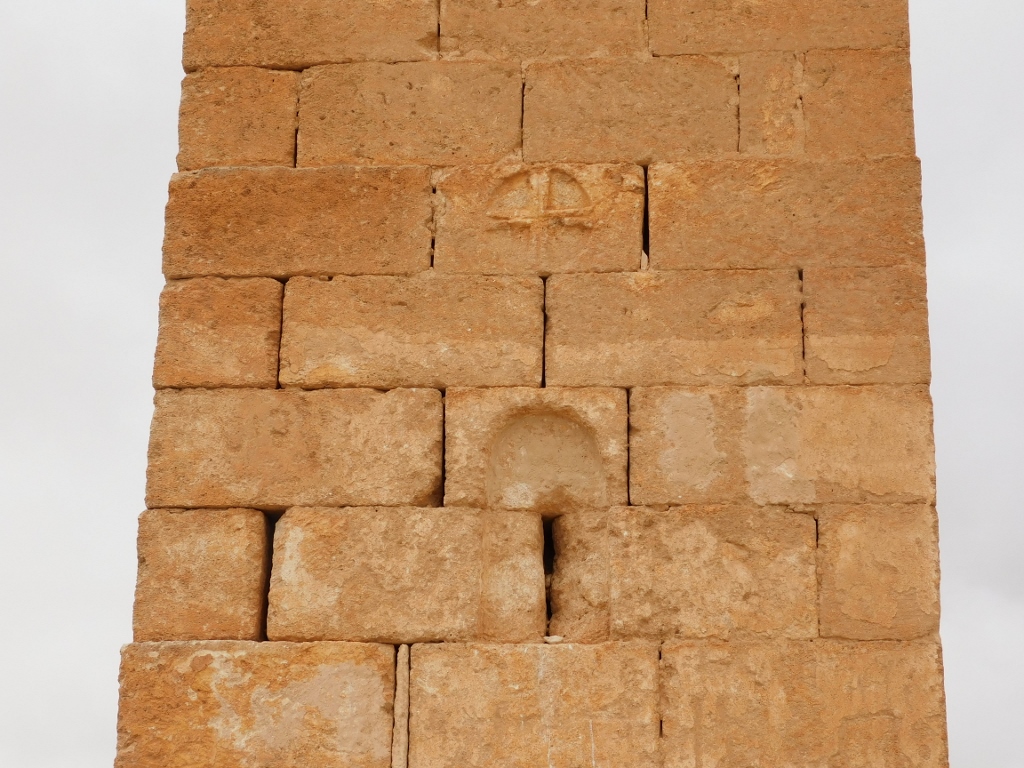 Stylite tower, a detail
Stylite tower, a detail
Within the complex, there are a few more structures, but I must admit I was not interested in visiting them. I only paid attention to the remains of the church built beside the tower. It was a small basilica.
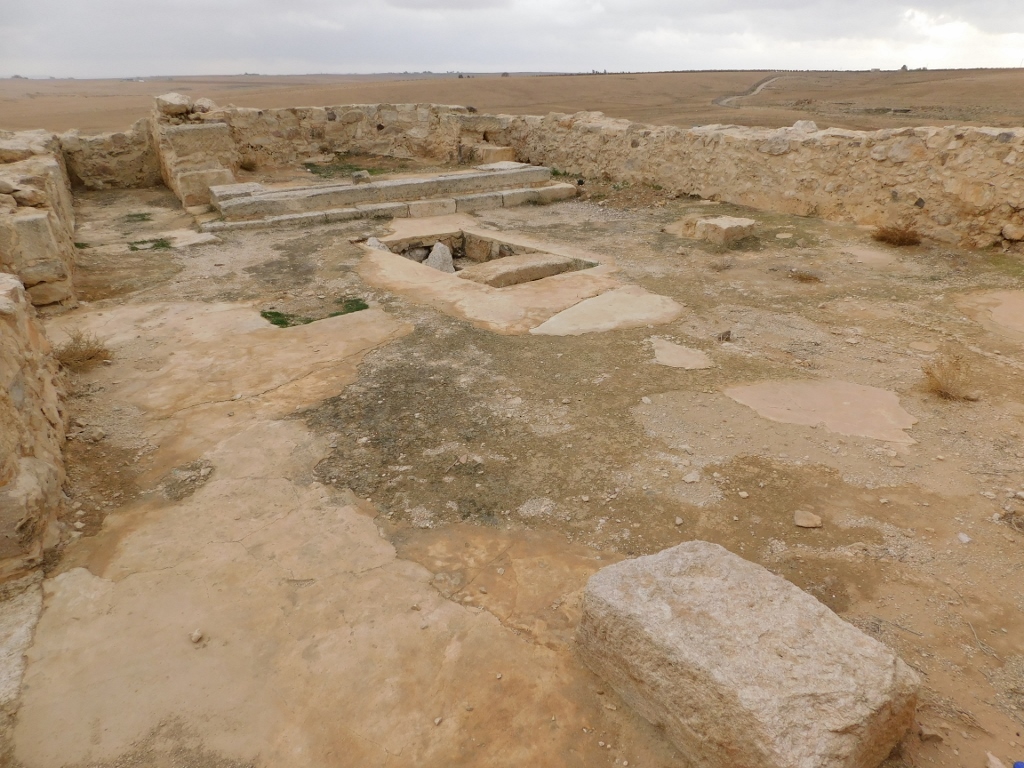 Remains of the church within the Stylite Tower Complex
Remains of the church within the Stylite Tower Complex
After this I felt like walking a little in order to see better an olive grove that I caught my eye as we approached this place, but I also kept looking back and at some point I saw the tower again.
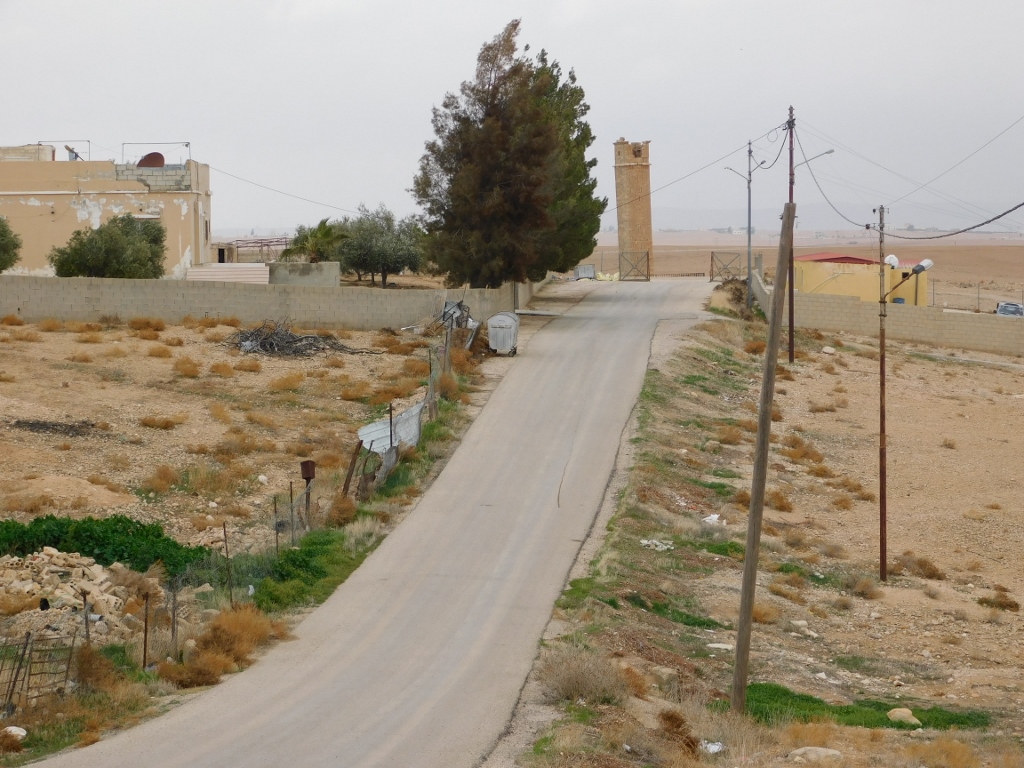 View at the Stylite Tower
View at the Stylite Tower
Nearby, there was this olive grove that with its greenness stood out so wonderfully in comparison to the surrounding desert.
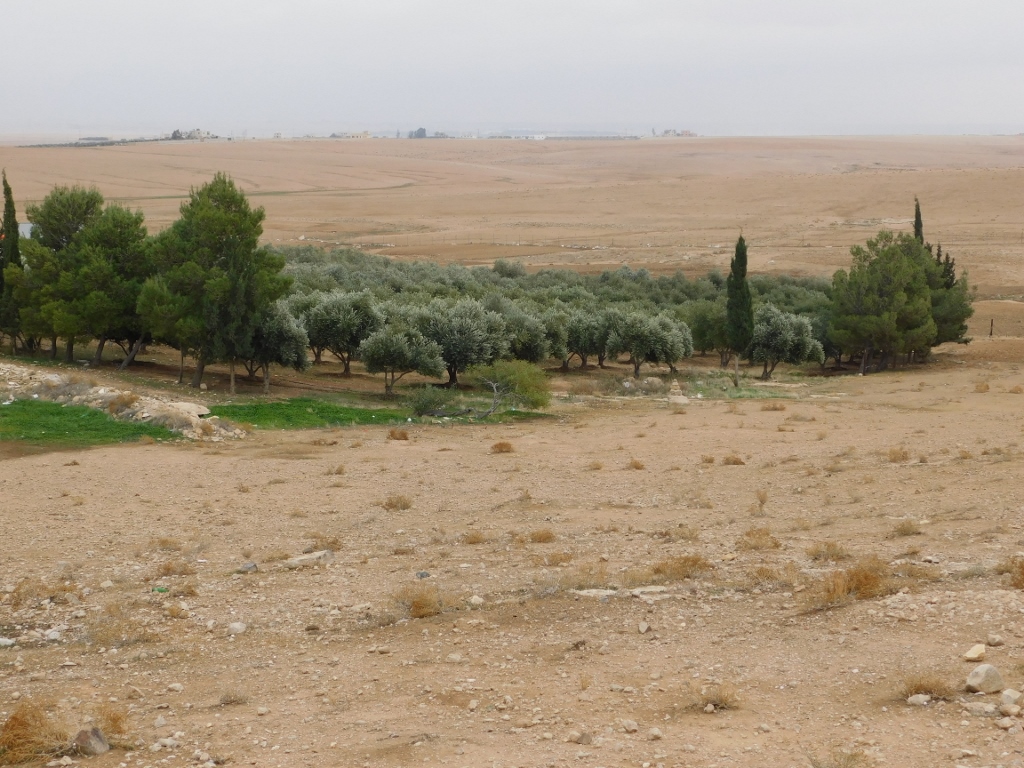 Olive grove close to the Stylite Tower
Olive grove close to the Stylite Tower
A little later I noticed from the car a very interesting structure in the distance and I was sure it was a traditional dovecot. However, it came as a special treat when back home, after my return, when I was sorting out my photos, I noticed a kestrel standing near the top of the dovecot.
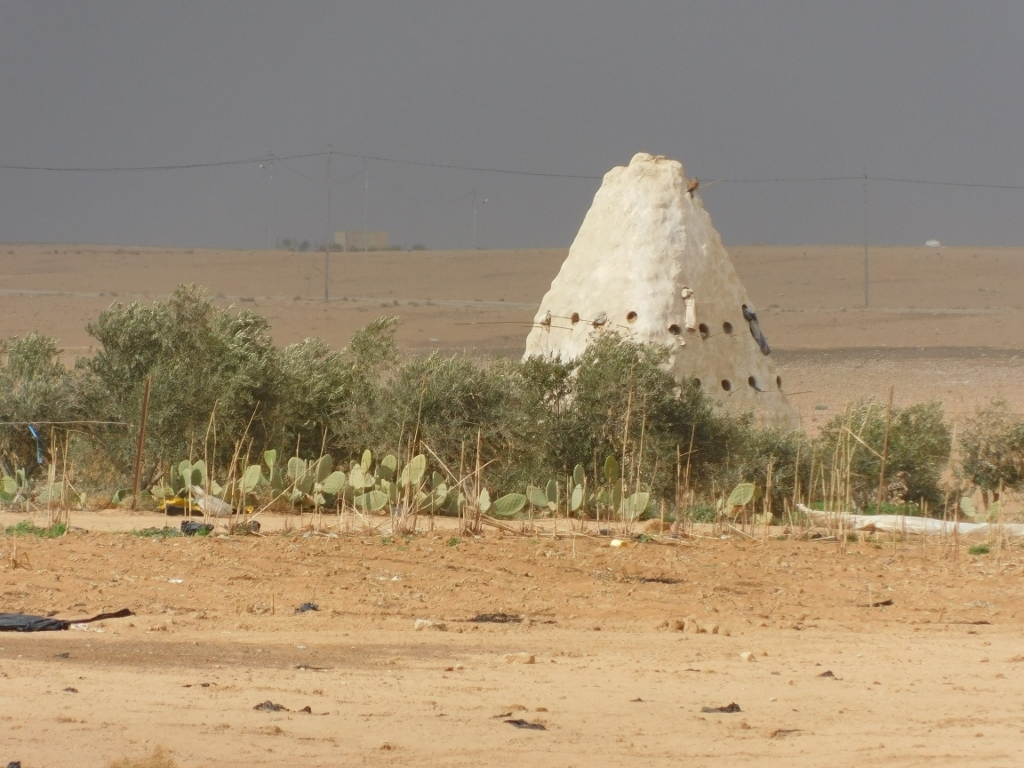 A dovecote and a kestrel
A dovecote and a kestrel
And then, a real adventure started. I wanted to visit Qasr Bshir, but none of my guidebooks had any mention of it. On the other hand, this Roman fortress is listed in the UNESCO’s Tentative World Heritage List. In other words, I thought it was a must, especially since I was in the area close to it.
But, it was not easy finding this place and so Abdullah had to make a couple of stops and inquire. We barely managed to get some information as to where we should turn from the Desert Highway, while the weather was... Well, it was uncertain.
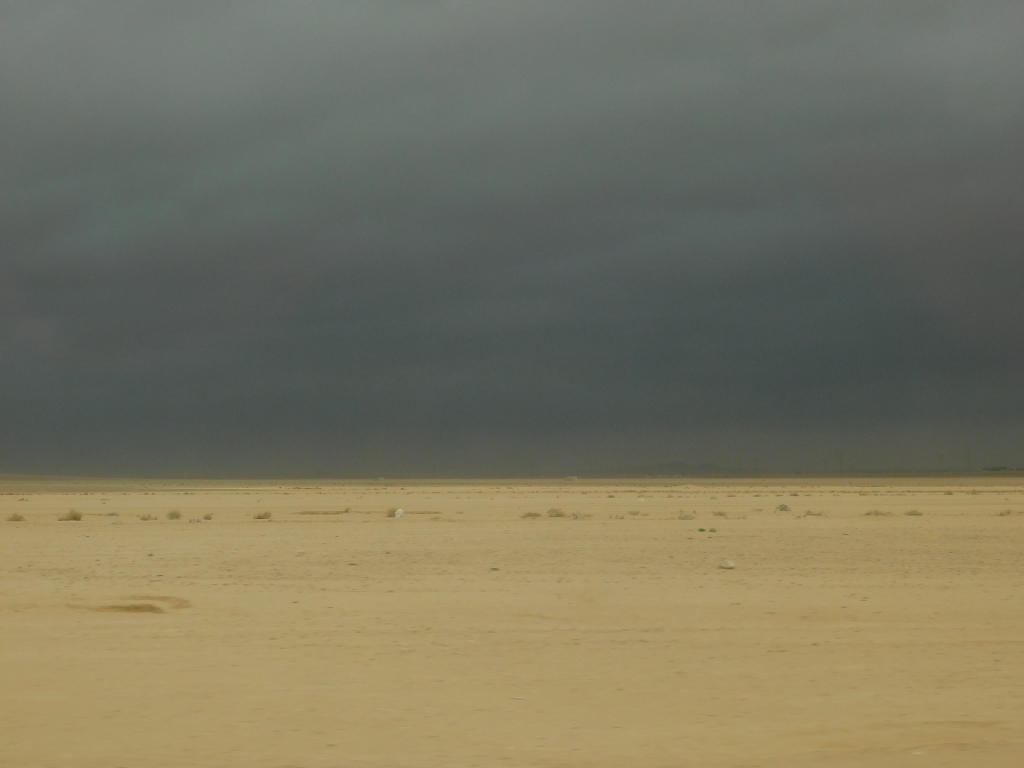 Dark clouds above the desert
Dark clouds above the desert
So, we headed west driving on an asphalt road. At first we went past some overhead power lines and some industrial facilities, but soon there was only desert around us. Up until one moment when in the distance I noticed something that could be some kind of a fortress.
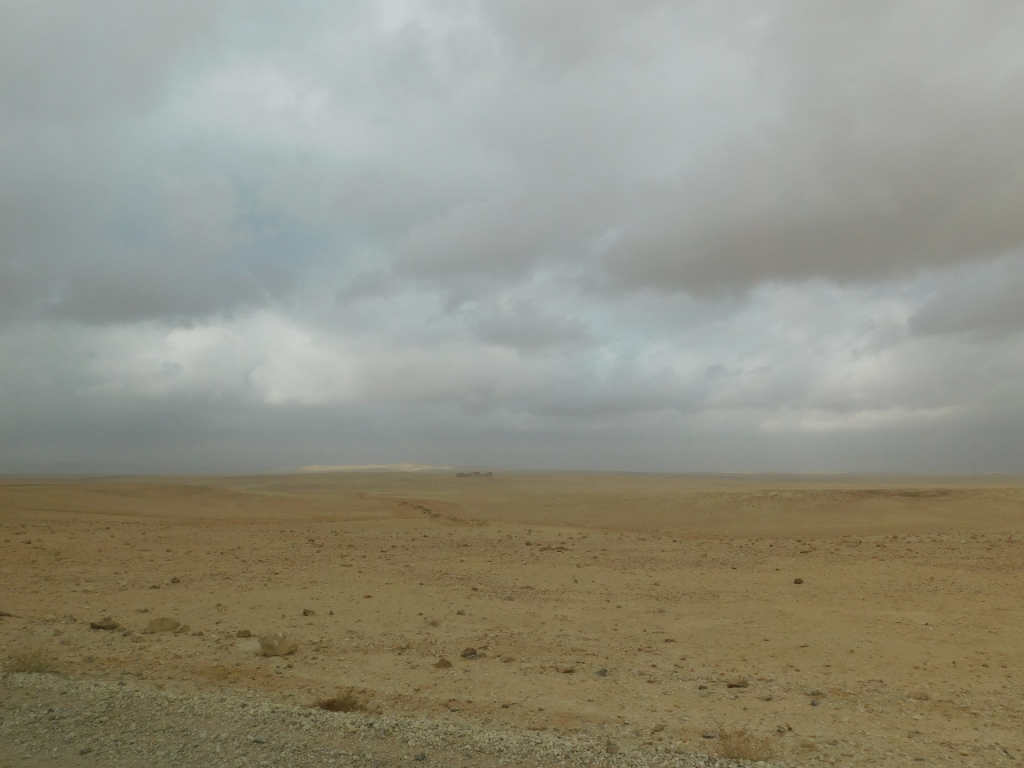 Fortress in the distance
Fortress in the distance
As we continued along the road, I was more and more certain that this was precisely what I was looking for and then at some point Abdullah stopped so that I could zoom in the fortress.
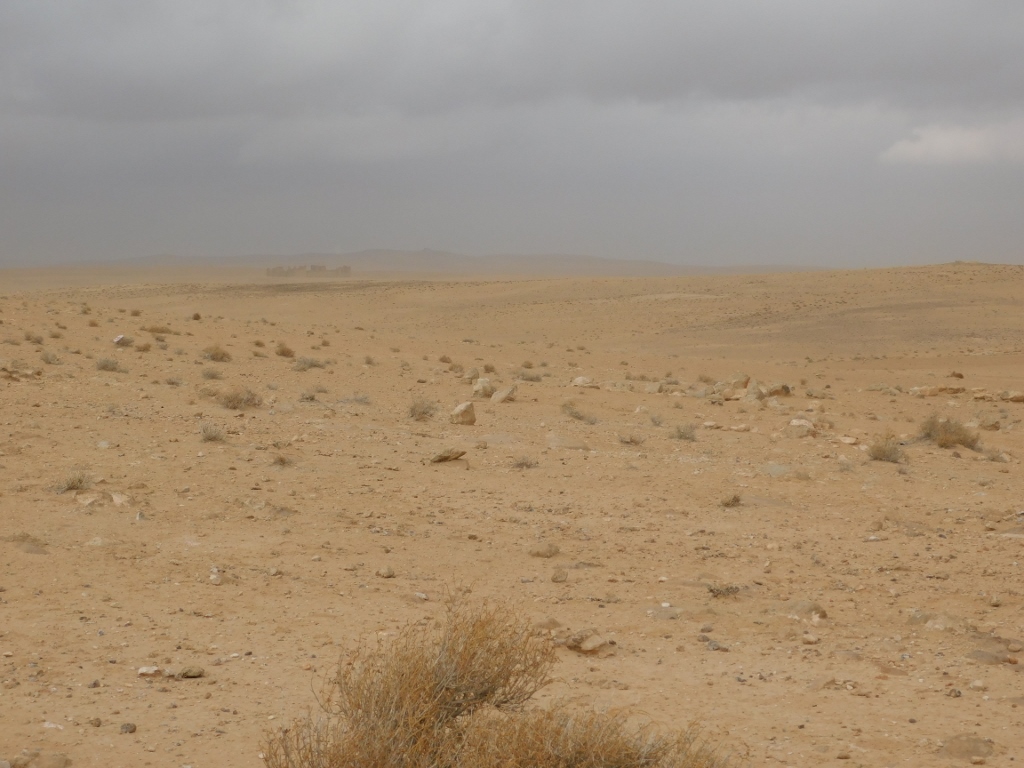 Fortress in the middle of the desert
Fortress in the middle of the desert
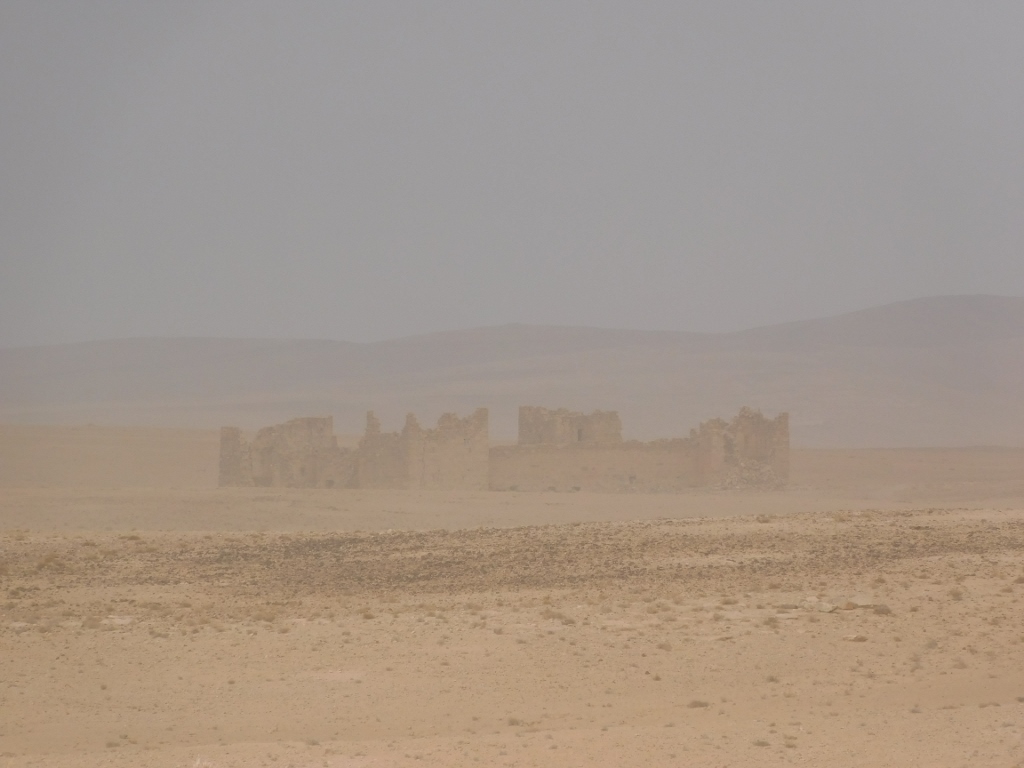 Fortress in the middle of the desert
Fortress in the middle of the desert
We continued, all the way expecting some turn, but soon enough the fortress started to remain behind us. Far away from the road, on the right-hand side, but behind us.
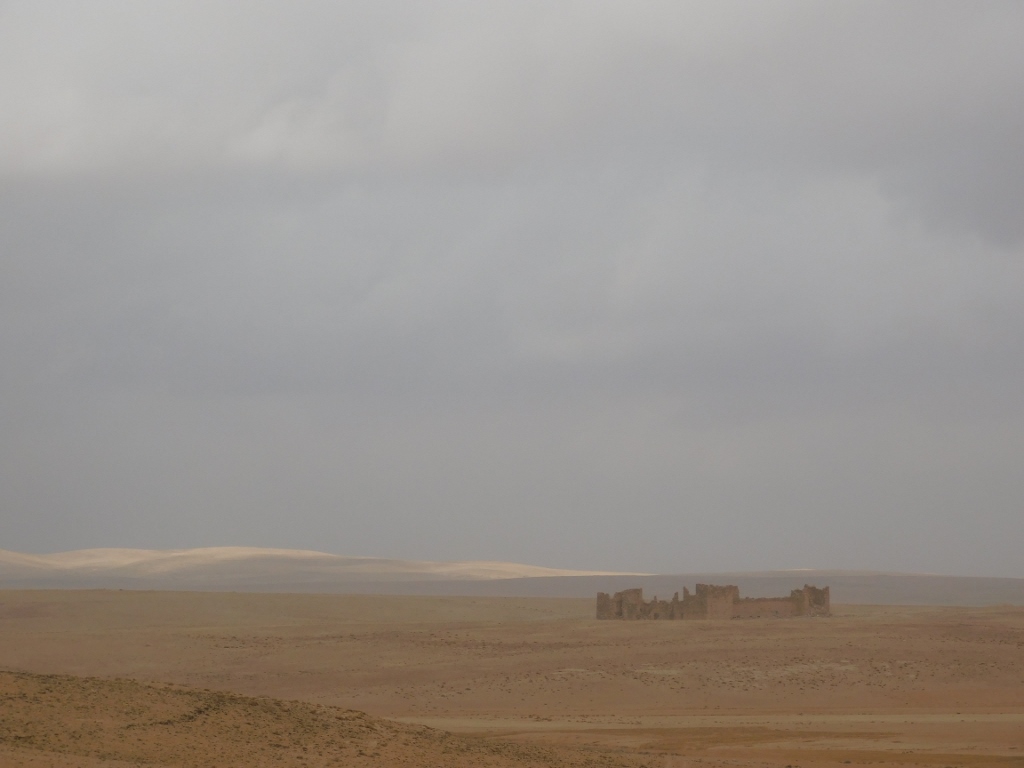 Fortress in the middle of the desert
Fortress in the middle of the desert
Meanwhile, that nice asphalt road disappeared and the dirt road we were on contained only very sporadic remains for some former asphalt that was probably laid down here way back when.
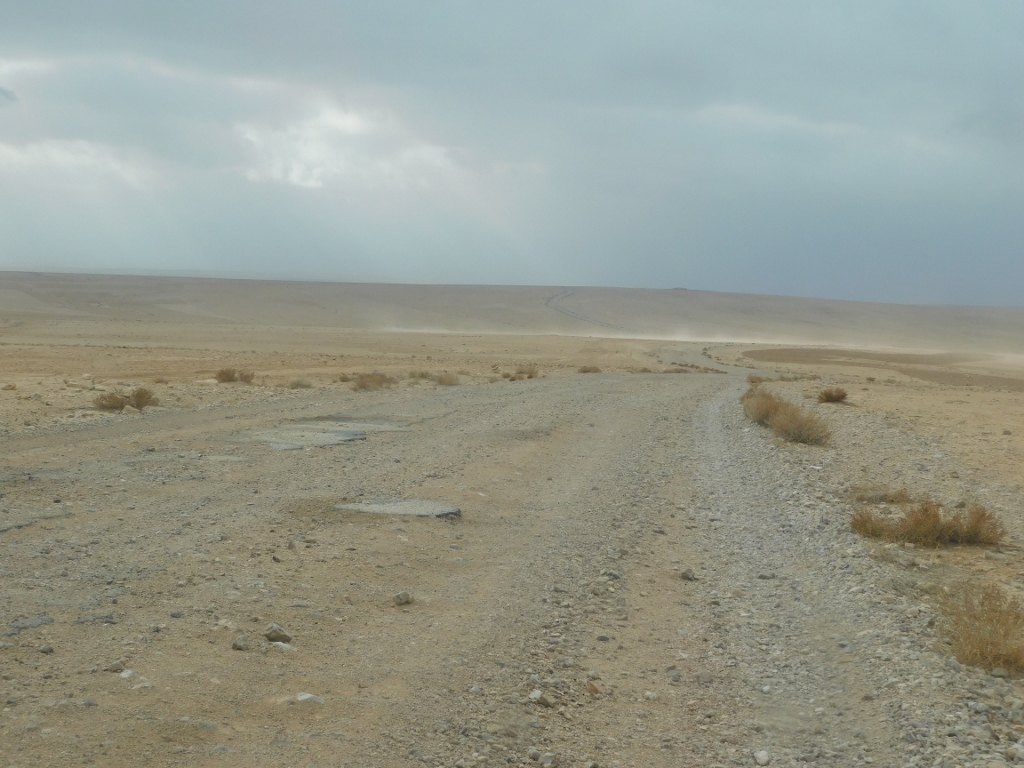 The road less travelled
The road less travelled
Then I proposed to Abdullah that we should turn back, for there was no point in pressing on, thinking that we should return to Karak. In the distance I could see the stormwind pick up the sand and even farther away I could barely discern the tops of the overhead power lines. But, as it was extremely windy, some holes appeared in the cloudy sky and the sunlight then managed to reach the ground. The imposing nature of the sights left me speechless. Especially from the comfortable and warm car in which there was no wind.
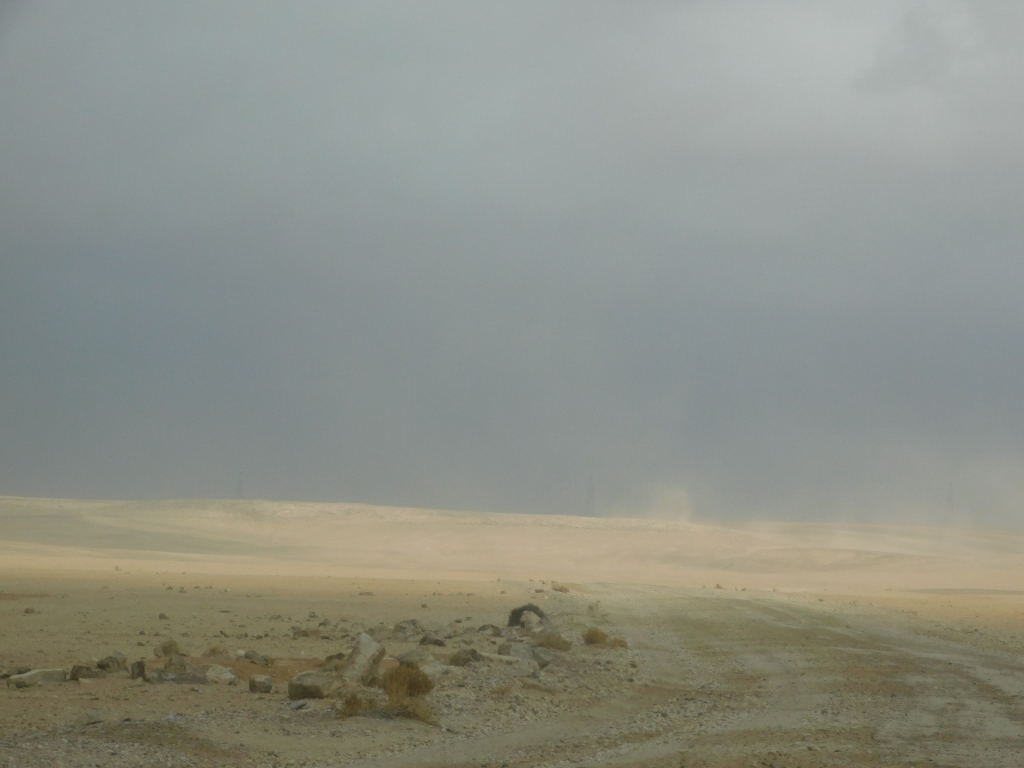 Desert storm
Desert storm
And then, at some point, Abdullah turned off this dirt road, long ago an asphalt road, to a “road” that led across the desert. I thought that only Bedouins came here by their cars, for the traces of wheels could be distinguished, but there was nothing else anywhere around.
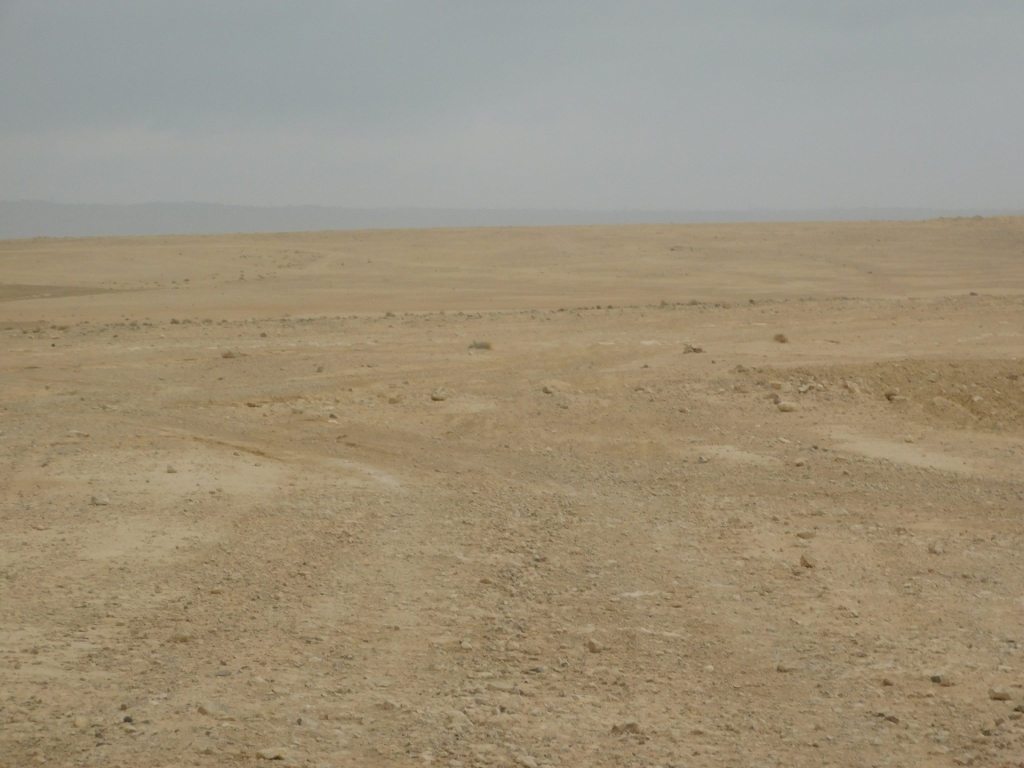 Driving through the desert
Driving through the desert
And yet, we had the landmark and that was the Qasr Bshir fortress. The overhead power lines that could be glimpsed in the distance did not matter.
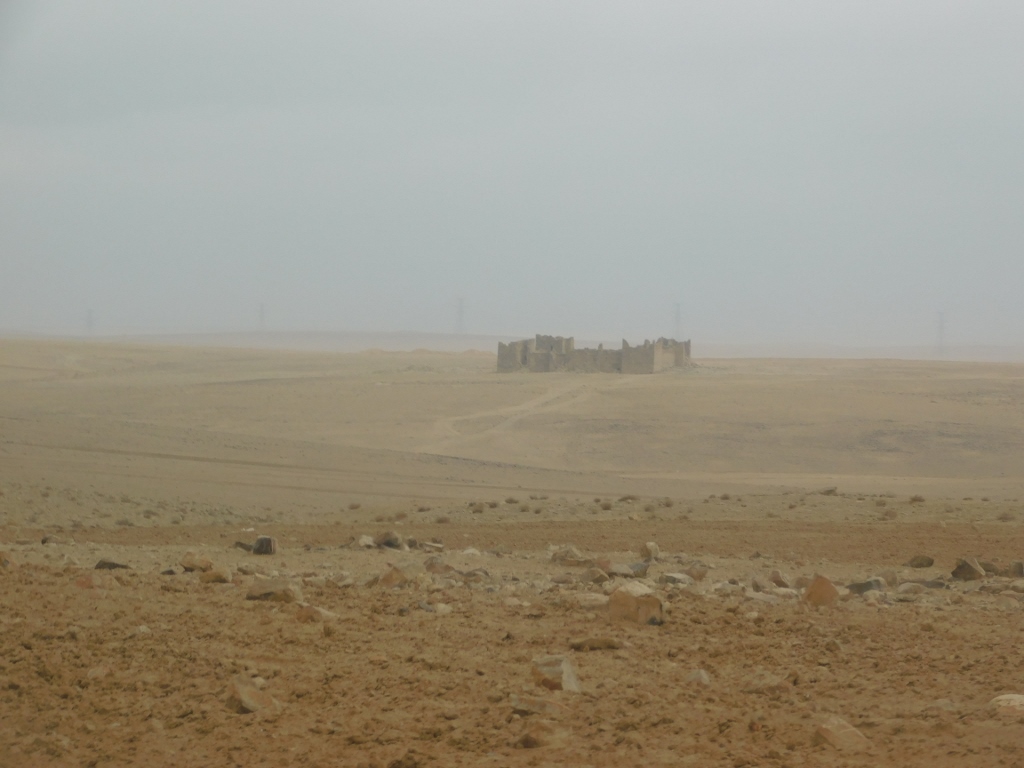 Qasr Bshir fortress in the middle of the desert
Qasr Bshir fortress in the middle of the desert